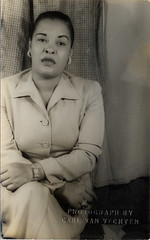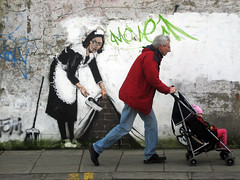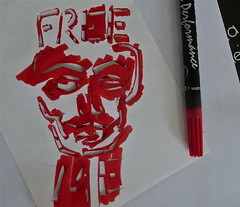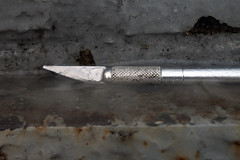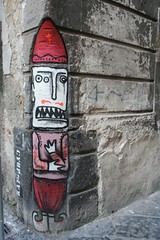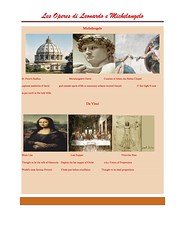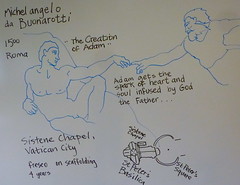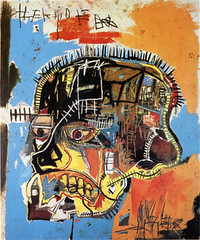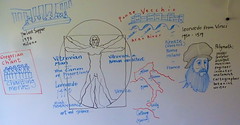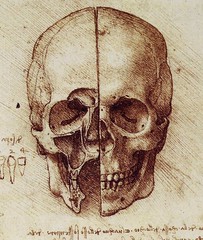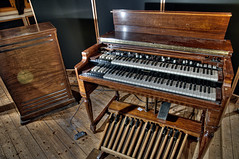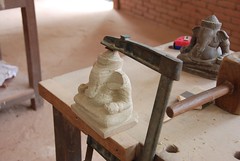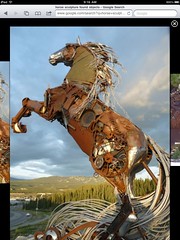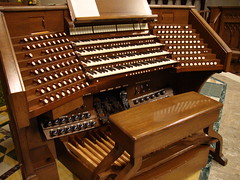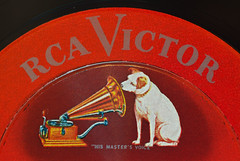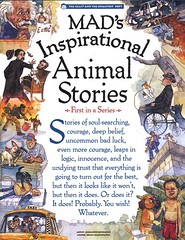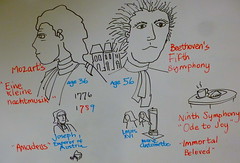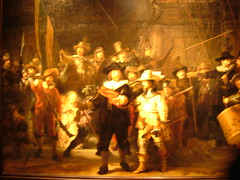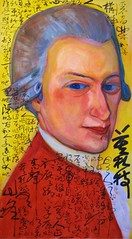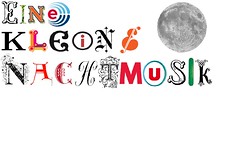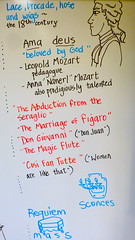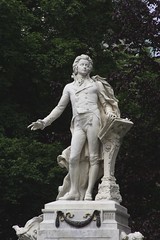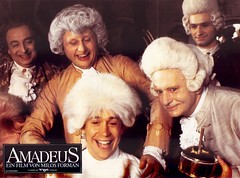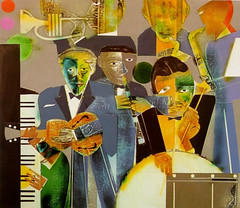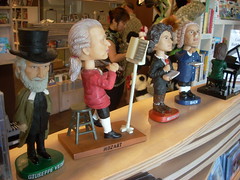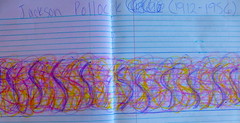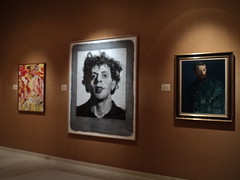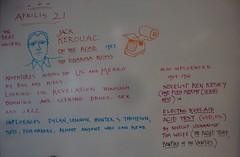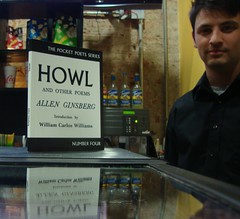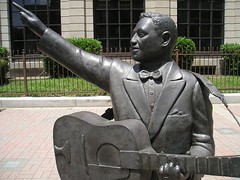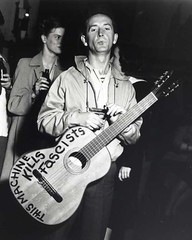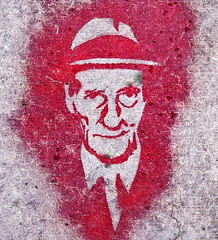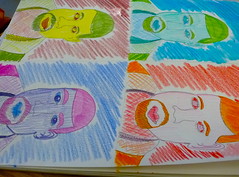Carl Van Vechten (1880 – 1964) was an American writer and photographer who was a patron of the Harlem Renaissance and the literary executor of Gertrude Stein, says Wikipedia.[1]
Born in Cedar Rapids, Iowa, he graduated from Washington High School in 1898,[2] and later the University of Chicago[3] in 1903. In 1906, he moved to New York City. He was hired as the assistant music critic at the New York Times. His interest in opera had him take a leave of absence from the paper in 1907, to travel to Europe to explore opera.[1] While in England he married his long time friend from Cedar Rapids, Anna Snyder.
He returned to his job at the New York Times in 1909 and then became the first American critic of modern dance. At that time, Isadora Duncan, Anna Pavlova, and Loie Fuller were performing in New York City. The marriage to Anna Snyder ended in divorce in 1912 and he wed actress Fania Marinoff in 1914.[4]
Although Van Vechten was married to Fania Marinoff until the end of his life, he was either homosexual or bisexual.[5] Some of his papers were kept under seal for twenty-five years after his death, and when they were examined after that time, they were found to include scrapbooks of photographs and clippings related to homosexuality.[6]
Several books of Van Vechten's essays on various subjects such as music and literature were published between 1915 and 1920. Between 1922 and 1930 Knopf published seven novels by Van Vechten, starting with Peter Whiffle: His Life and Works and ending with Parties.[7]
Van Vechten was interested in black writers and artists, and knew and promoted many of the major figures of the Harlem Renaissance, including Langston Hughes, Ethel Waters, Richard Wright, and Wallace Thurman. Van Vechten's controversial novel Nigger Heaven[3] was published in 1926. His essay "Negro Blues Singers" was published in Vanity Fair in 1926.
In the 1930s, Van Vechten began taking portrait photographs. Among the many individuals he photographed were Edward Albee, Judith Anderson, Marian Anderson, Pearl Bailey, Josephine Baker, James Baldwin, Tallulah Bankhead, Barbara Bel Geddes, Thomas Hart Benton, Jane Bowles, Marlon Brando, Paul Cadmus, Erskine Caldwell, Truman Capote, Bennett Cerf, Marc Chagall, Salvador Dalí, Ruby Dee, Jacob Epstein, Ella Fitzgerald, F. Scott Fitzgerald, Lynn Fontanne, John Hersey, Billie Holiday, Lena Horne, Horst P. Horst, Mahalia Jackson, Philip Johnson, Frida Kahlo, Eartha Kitt, Gaston Lachaise, Sidney Lumet, Alfred Lunt, Norman Mailer, Alicia Markova, Henri Matisse, W. Somerset Maugham, Henry Miller, Joan Miró, Ramon Novarro, Georgia O'Keeffe, Laurence Olivier, Christopher Plummer, Leontyne Price, Diego Rivera, Jerome Robbins, Paul Robeson, Cesar Romero, George Schuyler, Beverly Sills, Gertrude Stein, James Stewart, Alfred Stieglitz, Ada "Bricktop" Smith, Bessie Smith, Alice B. Toklas, Prentiss Taylor, Gore Vidal, Evelyn Waugh, Orson Welles, Thornton Wilder, and Anna May Wong.[8][9]
Sunday, July 14, 2013
Friday, May 17, 2013
Herb and Dorothy, a documentary film by Megumi Sasaki; You don't have to be a Rockefeller to collect art
Herb and Dorothy is a 2008 documentary film by Megumi Sasaki, says Wikipedia.
The film tells the story of two middle-class collectors of contemporary art, Herbert and Dorothy Vogel, and the enormous and valuable collection of conceptual art and minimalist art they amassed.[2]
Many artists are interviewed in the film, including Christo, Chuck Close, Robert Mangold, and Pat Steir.
The film tells the story of two middle-class collectors of contemporary art, Herbert and Dorothy Vogel, and the enormous and valuable collection of conceptual art and minimalist art they amassed.[2]
Many artists are interviewed in the film, including Christo, Chuck Close, Robert Mangold, and Pat Steir.
Series of lectures and videos on street art
- Banksy, British master of the witty, detailed, stenciled paste-ups.
- Shepard Fairey, American poster maker and oft-arrested street artist.
- JR, artist, the French photographer and winner of the 2011 TED Prize.
- MTO, the Garman artist behind "fast Life" and "Dr Robinson," in Sarasota, Fl.
- Blek le Rat, the "father of stencils" on the streets of Paris.
Parcours - the acrobatic form of rebellious street art in movement.
See more on street art.
- Shepard Fairey, American poster maker and oft-arrested street artist.
- JR, artist, the French photographer and winner of the 2011 TED Prize.
- MTO, the Garman artist behind "fast Life" and "Dr Robinson," in Sarasota, Fl.
- Blek le Rat, the "father of stencils" on the streets of Paris.
Parcours - the acrobatic form of rebellious street art in movement.
See more on street art.
Sunday, May 12, 2013
Tuesday, May 7, 2013
Please purchyse or borrow an Xacto knife for next class
Street art: stencil cutting.
You need an xacto knife, which is a versatile tool to have around the house. Please buy or borrow one for next class.
You need an xacto knife, which is a versatile tool to have around the house. Please buy or borrow one for next class.
Once called graffiti, the term today is Street Art
We have 3 street artists on the fine arts agenda this week:
- Shepard Fairey, a former skater and RISD grad.
- Banksy, the secretive British master of the witty stencil. He has travelled globally to paste up his visual meditations. Even to New Orleans.
- JR, the artist. This anonymous French photographer has been internationally lauded for his aid to developing nations and slums via his photo-based street art.
- Shepard Fairey, a former skater and RISD grad.
- Banksy, the secretive British master of the witty stencil. He has travelled globally to paste up his visual meditations. Even to New Orleans.
- JR, the artist. This anonymous French photographer has been internationally lauded for his aid to developing nations and slums via his photo-based street art.
Wednesday, May 1, 2013
Leonardo da Vinci and Michelangelo Buonarotti
How to tell the two Renaissance Men apart:
- One page project.
- Three images each.
- Each image includes brief, identifying factoids.
- Vivid title.
- One page project.
- Three images each.
- Each image includes brief, identifying factoids.
- Vivid title.
Tuesday, April 30, 2013
Senior exam: one-page comparison essay on 2 artists, such as Basquiat and Kahlo
Any of the artists we've studied in fine arts survey!
- titles
- dates
- locations
- third person
- scholarly tone
- documentation
- jazzy title
- titles
- dates
- locations
- third person
- scholarly tone
- documentation
- jazzy title
Tuesday, April 23, 2013
K'Naan, Alt-J and Youth Lagoon: music away from the mainstream
Off-the-beaten-path music presentations!
Red Baraat
Alt-J
Youth Lagoon
Alexander Rybak
Say a few biographical and explicatory words and play the video! 10 pts.
My favorite today was "Breezeblocks" by Alt-J. Stunning film.
Red Baraat
Alt-J
Youth Lagoon
Alexander Rybak
Say a few biographical and explicatory words and play the video! 10 pts.
My favorite today was "Breezeblocks" by Alt-J. Stunning film.
Monday, April 22, 2013
Leonardo da Vinci / Renaissance art
Leonardo Supper Quiz
1. Leonardo's equestrian statue, "Gran cavallo," was never cast in bronze though it inspired awe as a giant clay sculpture. The subject was a __ . a) prince b) eagle c) horse d) castle.
2. L was raised in the vicinity of the city that was a center of Renaissance arts from the 14th to 16th centuries, Firenze. Today Firenze, located on the famous Arno River, is known as __, which means "flower." a) Florence b) Bologna c) Venetia d) Roma.
3. In Firenze visitors find a Medieval enclosed bridge called the "__ Vecchio." This bridge integrated shops into the structure. Once the stores featured butchers; today the storefronts are occupied by jewelers and art dealers.
a) Regulare b) Ponte c) Duomo d) Arco.
4. As a young man L was apprenticed to a studio where he learned drafting, chemistry, metallurgy, metal working, plaster casting, leather working, mechanics and carpentry as well as the artistic skills of drawing, painting, sculpting and modelling. It was the workshop operated by the famous artist __ . a) Michelangelo b) Botticelli c) Ludovico il Moro d) Andrea del Verrocchio.
5. The Last Supper was painted for a __ . a) monastery b) library c) museum d) art gallery
6. The Last Supper is a mural. Such works were ordinarily painted via the style called __, in which paint is applied to wet plaster. a) watercolor b) pastel c) fresco d) relief.
7. The Last Supper is on display in the city of a) Milan b) Florence c) Roma d) Bologna.
8. The figures in Supper are __ life size. a) larger than b) one half c) three quarters.
9. Much of his work was not performed as an artist but as an architect and designer to aid his royal employers in their __ . a) religious duties b) wars c) public buildings d) personal residences.
10. Cesare Borgia's stronghold city, Imola, was celebrated and aided by a __ developed by Leonardo. a) canal b) map c) fortified wall d) system of wells.
11. Leonardo was a bastard, or illegitimate child. T / F
12. His life of 57 years surrounded the year of __ . a) 1300 b) 1400 c) 1500 d) 1600.
13. In traditional paintings of The Last Supper one person is often placed on the other side of the table from the remaining apostles: __ . This was not true in Leonardo's version. a) Peter b) Judas c) Matthew d) Paul.
14. Leonardo did not die in Italy. In has last years he was employed and housed by Francis I, King of __ . a) France b) Germany c) Espana d) England.
15. Leonardo was sporadic and dilatory; his rate of work could be called __ . a) fast b) slow c) erratic.
Wednesday, April 17, 2013
The rich organ sound in gospel, jazz and rock music: the Hammond B3
While the Hammond organ was originally sold to churches as a lower-cost alternative to the wind-driven pipe organ, in the 1960s and 1970s it became a standard keyboard instrument for jazz, blues, rock, church and gospel music.
The original Hammond organ used additive synthesis of waveforms from harmonic series made by mechanical tonewheels that rotate in front of electromagnetic pickups.
In the late 1960s and throughout the 1970s the distinctive sound of the B-3 organ (often played through a Leslie speaker) was widely used in blues, progressive rock bands and blues-rock groups.The Leslie speaker creates special audio effects using the Doppler effect by rotating the speakers or a sound-directing duct.
Named after its inventor, Donald Leslie, it is particularly associated with the Hammond organ, says Wikipedia, but is used with a variety of instruments as well as vocals.
Leslie originally bought a Hammond organ in 1937, in the hope it would be a suitable substitute for a pipe organ, but was disappointed with the sound in his home compared to the large showroom where he had originally heard it. Consequently, he attempted to design a speaker to overcome this. He initially tried making a cabinet similar to Hammond's own, but then surmised the variation in sound a pipe organ produced because of the different location of each pipe meant he should try making a moving speaker. He developed the familiar combination of a rotating drum and horn for bass and treble frequencies respectively.[1]
The original Hammond organ used additive synthesis of waveforms from harmonic series made by mechanical tonewheels that rotate in front of electromagnetic pickups.
In the late 1960s and throughout the 1970s the distinctive sound of the B-3 organ (often played through a Leslie speaker) was widely used in blues, progressive rock bands and blues-rock groups.The Leslie speaker creates special audio effects using the Doppler effect by rotating the speakers or a sound-directing duct.
Named after its inventor, Donald Leslie, it is particularly associated with the Hammond organ, says Wikipedia, but is used with a variety of instruments as well as vocals.
Leslie originally bought a Hammond organ in 1937, in the hope it would be a suitable substitute for a pipe organ, but was disappointed with the sound in his home compared to the large showroom where he had originally heard it. Consequently, he attempted to design a speaker to overcome this. He initially tried making a cabinet similar to Hammond's own, but then surmised the variation in sound a pipe organ produced because of the different location of each pipe meant he should try making a moving speaker. He developed the familiar combination of a rotating drum and horn for bass and treble frequencies respectively.[1]
Alternative to college and the white collar world: becoming an artisan
An artisan or artizan (from French: artisan, Italian: artigiano) or craftsman (craftsperson)[1] is a skilled manual worker who makes items that may be functional or decorative, says Wikipedia.
Exs -
furniture, sculpture, clothing, jewellery, furniture, tools or even machines such as the handmade devices of a watchmaker.
An artisan is therefore a person engaged in or occupied by the practice of a craft, who may through experience and talent reach the expressive levels of an artist using his hands, mind and heart in his work and what he creates.
Some examples -
- wooden boats
- guitars (luthier)
- organ pipes (metallurgy)
- sea salt
- herbal olive oil
- soaps
- custom fabrics
- treehouses
- saddles
- chimes, bells
- carburetors
- beers
- paper and print
Exs -
furniture, sculpture, clothing, jewellery, furniture, tools or even machines such as the handmade devices of a watchmaker.
An artisan is therefore a person engaged in or occupied by the practice of a craft, who may through experience and talent reach the expressive levels of an artist using his hands, mind and heart in his work and what he creates.
Some examples -
- wooden boats
- guitars (luthier)
- organ pipes (metallurgy)
- sea salt
- herbal olive oil
- soaps
- custom fabrics
- treehouses
- saddles
- chimes, bells
- carburetors
- beers
- paper and print
Recycled metal mustang / possible Caddo Magnet HS project
Fine arts students should help in the process of exploring the recycled metals mustang project.
Research . . .
- variety of images
- construction techniques
- size
- mounting
- locations
- function(s)
- format: free-standing, relief, etc.
Sketches
Maquette (small model of proposed sculpture)
From PTSA pres Amanda Bertrand:
**Mustang Sculpture Project**
We are attempting to gather the metal objects needed for the Mustang Sculpture Project that will placed in the courtyard. This will be a life size sculpture made from pieces and parts submitted by the students. We are primarily focusing on rusty metal but may use some items made of alternative metals. Some of the items we are considering in the construction of the sculpture might be:
Saw blades
Garage door or other springs
Steel posts or beams
Rusty tools
Discarded hardware
Nuts and bolts
Plow discs
Piping and tubing
Farming implements
Railroad spikes
Scrap angle iron and plate
Rebar
Car or motorcycle parts
Propane or other metal gas tanks
Metal gears
Pulleys
Wagon wheels
Mufflers
Chain or shackles
Pipe fittings
Steel bicycle rims or parts
Horse shoes
Brake drums
Machinery repair parts
Bearings
I-beam or channel iron
Copper wiring
Discarded shovel or rake heads
Industrial lighting fixtures
Drill bits
Metal cable
Metal rings
Discarded hot water heaters
Other interesting metal objects
Metal hubcaps
All rusty metal will be considered. Keep in mind that these are just ideas.
The possibilities are endless…
Be creative and think of items that might resemble horse anatomy.
More information will follow. Message this site for drop-off instructions.
Research . . .
- variety of images
- construction techniques
- size
- mounting
- locations
- function(s)
- format: free-standing, relief, etc.
Sketches
Maquette (small model of proposed sculpture)
From PTSA pres Amanda Bertrand:
**Mustang Sculpture Project**
We are attempting to gather the metal objects needed for the Mustang Sculpture Project that will placed in the courtyard. This will be a life size sculpture made from pieces and parts submitted by the students. We are primarily focusing on rusty metal but may use some items made of alternative metals. Some of the items we are considering in the construction of the sculpture might be:
Saw blades
Garage door or other springs
Steel posts or beams
Rusty tools
Discarded hardware
Nuts and bolts
Plow discs
Piping and tubing
Farming implements
Railroad spikes
Scrap angle iron and plate
Rebar
Car or motorcycle parts
Propane or other metal gas tanks
Metal gears
Pulleys
Wagon wheels
Mufflers
Chain or shackles
Pipe fittings
Steel bicycle rims or parts
Horse shoes
Brake drums
Machinery repair parts
Bearings
I-beam or channel iron
Copper wiring
Discarded shovel or rake heads
Industrial lighting fixtures
Drill bits
Metal cable
Metal rings
Discarded hot water heaters
Other interesting metal objects
Metal hubcaps
All rusty metal will be considered. Keep in mind that these are just ideas.
The possibilities are endless…
Be creative and think of items that might resemble horse anatomy.
More information will follow. Message this site for drop-off instructions.
Monday, April 15, 2013
The massive bank of stops in a pipe organ console; bass bars under the keyboard played by feet
"Toccata and Fugue in D Minor" is one of the world's notable Bach organ pieces.
The pipe organ is a musical instrument that produces sound by driving pressurized air (called wind) through pipes selected via a keyboard.
Each organ pipe produces a single pitch.
Most organs have multiple ranks of pipes of differing timbre, pitch and loudness that the player can employ singly or in combination through the use of controls called stops.
A pipe organ has one or more keyboards (called manuals) played by the hands, and a pedalboard played by the feet, each of which has its own group of stops.
The organ's continuous supply of wind allows it to sustain notes for as long as the corresponding keys are depressed, unlike the piano and harpsichord whose sound begins to decay immediately after attack.
The smallest portable pipe organs may have only one or two dozen pipes and one manual; the largest may have over 20,000 pipes and seven manuals.[2]
The origins of the pipe organ can be traced back to the hydraulis in Ancient Greece in the 3rd century BC,[3] in which the wind supply was created with water pressure.
The pipe organ is a musical instrument that produces sound by driving pressurized air (called wind) through pipes selected via a keyboard.
Each organ pipe produces a single pitch.
Most organs have multiple ranks of pipes of differing timbre, pitch and loudness that the player can employ singly or in combination through the use of controls called stops.
A pipe organ has one or more keyboards (called manuals) played by the hands, and a pedalboard played by the feet, each of which has its own group of stops.
The organ's continuous supply of wind allows it to sustain notes for as long as the corresponding keys are depressed, unlike the piano and harpsichord whose sound begins to decay immediately after attack.
The smallest portable pipe organs may have only one or two dozen pipes and one manual; the largest may have over 20,000 pipes and seven manuals.[2]
The origins of the pipe organ can be traced back to the hydraulis in Ancient Greece in the 3rd century BC,[3] in which the wind supply was created with water pressure.
His Master's Voice: the fine arts blindfold test
A listening test for fine arts students -
Beethoven:
- Fifth Symphony
- Ninth Symphony
Bach
- Tocata and fugue for pipe organ
- Brandenburg Concertos. 1 - 8 (No. 5)
Mozart
- Eine kleine nachtmusik
- Don Giovanni
- The Magic Flute
- The Marriage of Figaro
Beethoven:
- Fifth Symphony
- Ninth Symphony
Bach
- Tocata and fugue for pipe organ
- Brandenburg Concertos. 1 - 8 (No. 5)
Mozart
- Eine kleine nachtmusik
- Don Giovanni
- The Magic Flute
- The Marriage of Figaro
MAD Magazine and the history of satire
William Hogarth, satirist painter and print maker in 18th century England. He looked askance at society and its failings in series such as "Beer Street and Gin Lane,: :The Harlot's Progress." "The Rake's Progress" and "Marriage a la Mode."
Geoffrey Chaucer satirized friars, goverment officials and merchants, among many, in "The Canterbury Tales."
Jonathan Swift is remembered for works such as Gulliver's Travels, A Modest Proposal, An Argument Against Abolishing Christianity, and A Tale of a Tub. Swift is probably the foremost prose satirist in the English language.
Lewis Carroll, aka Charles Dodgson, is notable for the satirical Alice's Adventures in Wonderland and its sequel Through the Looking-Glass, as well as the poems "The Hunting of the Snark" and "Jabberwocky."
Mark Twain (Samuel Clemens) wrote The Adventures of Tom Sawyer (1876) and its sequel, Adventures of Huckleberry Finn (1885).
Thomas Nast (September 27, 1840 – December 7, 1902) was a German-born American caricaturist and editorial cartoonist who is considered to be the "Father of the American Cartoon".[1] He was the scourge of Boss Tweed and the Tammany Hall political machine. Among his notable works were the creation of the modern version of Santa Claus and the political symbol of the elephant for the Republican Party.
Local painter and print maker Leonard Maiden satirizes the casino life and the delusions of African-American people.
More . . .
Geoffrey Chaucer satirized friars, goverment officials and merchants, among many, in "The Canterbury Tales."
Jonathan Swift is remembered for works such as Gulliver's Travels, A Modest Proposal, An Argument Against Abolishing Christianity, and A Tale of a Tub. Swift is probably the foremost prose satirist in the English language.
Lewis Carroll, aka Charles Dodgson, is notable for the satirical Alice's Adventures in Wonderland and its sequel Through the Looking-Glass, as well as the poems "The Hunting of the Snark" and "Jabberwocky."
Mark Twain (Samuel Clemens) wrote The Adventures of Tom Sawyer (1876) and its sequel, Adventures of Huckleberry Finn (1885).
Thomas Nast (September 27, 1840 – December 7, 1902) was a German-born American caricaturist and editorial cartoonist who is considered to be the "Father of the American Cartoon".[1] He was the scourge of Boss Tweed and the Tammany Hall political machine. Among his notable works were the creation of the modern version of Santa Claus and the political symbol of the elephant for the Republican Party.
Local painter and print maker Leonard Maiden satirizes the casino life and the delusions of African-American people.
More . . .
Wednesday, April 10, 2013
Mozart and Beethoven: add Beethoven's Ninth Symphony, "Ode to Joy"
Written during the period before his death from ill health at age 56, the Ninth Symphony contains the popular "Ode to Joy" melody in the fourth movement.
Tuesday, April 9, 2013
CMHS Dance musical Fri, Ap 12, 6:30 pm
Lights, camera, graceful action: please plan to attend the dance program directed by Katerina Belyakova-Wise.
Over 40 students have a part in the show. Lighting by Will Flavin will be spectacular.
Over 40 students have a part in the show. Lighting by Will Flavin will be spectacular.
Actors re-create Rembrandt's painting The Night Watch - Rijksmuseum
Please check this: http://www.youtube.com/watch?feature=player_embedded&v=u8YhJs00nX0
Mozart: Eine kleine Nachtmusik
Eine kleine Nachtmusik (Serenade No. 13 for strings in G major) is a 1787 composition for a chamber ensemble by Wolfgang Amadeus Mozart, says Wikipedia.
The German title means "a little serenade," though it is often rendered more literally but less accurately as "a little night music."[1] The work is written for an ensemble of two violins, viola, and cello with optional double bass.
The serenade was completed in Vienna around the time Mozart was working on the second act of his opera Don Giovanni.[3]
Hildesheimer (1991, 215), noting that most of Mozart's serenades were written on commission, suggests that this serenade, too, was a commission.
The work was not published until about 1827, long after Mozart's death, by Johann André in Offenbach am Main.[2] It had been sold to this publisher in 1799 by Mozart's widow Constanze, part of a large bundle of her husband's compositions.
Today the serenade is widely performed and recorded; indeed both Jacobson (2003, 38) and Hildesheimer (1992, 215) opine that the serenade is the most popular of all Mozart's works. Of the music, Hildesheimer writes, "even if we hear it on every street corner, its high quality is undisputed, an occasional piece from a light but happy pen."[7]
The work has four movements:
Allegro
Romanze: Andante
Menuetto: Allegretto
Rondo: Allegro
Tempo terminology . . .
Larghissimo – very, very slow (19 BPM and under)
Grave – slow and solemn (20–40 BPM)
Lento – slowly (40–45 BPM)
Largo – broadly (45–50 BPM)
Adagio – slow and stately (literally, "at ease") (55–65 BPM)
Andante moderato – a bit slower than andante (69-72 BPM)
Andante – at a walking pace (73–77 BPM)
Marcia moderato – moderately, in the manner of a march[4][5] (83-85 BPM)
Moderato – moderately (86–97 BPM)
Allegro – fast, quickly and bright (109–132 BPM)
Vivace – lively and fast (132-140 BPM) (quicker than allegro)
Vivacissimo – very fast and lively (140-150 BPM)
Presto – very fast (168–177 BPM)
Prestissimo – extremely fast (178 BPM and over)
The German title means "a little serenade," though it is often rendered more literally but less accurately as "a little night music."[1] The work is written for an ensemble of two violins, viola, and cello with optional double bass.
The serenade was completed in Vienna around the time Mozart was working on the second act of his opera Don Giovanni.[3]
Hildesheimer (1991, 215), noting that most of Mozart's serenades were written on commission, suggests that this serenade, too, was a commission.
The work was not published until about 1827, long after Mozart's death, by Johann André in Offenbach am Main.[2] It had been sold to this publisher in 1799 by Mozart's widow Constanze, part of a large bundle of her husband's compositions.
Today the serenade is widely performed and recorded; indeed both Jacobson (2003, 38) and Hildesheimer (1992, 215) opine that the serenade is the most popular of all Mozart's works. Of the music, Hildesheimer writes, "even if we hear it on every street corner, its high quality is undisputed, an occasional piece from a light but happy pen."[7]
The work has four movements:
Allegro
Romanze: Andante
Menuetto: Allegretto
Rondo: Allegro
Tempo terminology . . .
Larghissimo – very, very slow (19 BPM and under)
Grave – slow and solemn (20–40 BPM)
Lento – slowly (40–45 BPM)
Largo – broadly (45–50 BPM)
Adagio – slow and stately (literally, "at ease") (55–65 BPM)
Andante moderato – a bit slower than andante (69-72 BPM)
Andante – at a walking pace (73–77 BPM)
Marcia moderato – moderately, in the manner of a march[4][5] (83-85 BPM)
Moderato – moderately (86–97 BPM)
Allegro – fast, quickly and bright (109–132 BPM)
Vivace – lively and fast (132-140 BPM) (quicker than allegro)
Vivacissimo – very fast and lively (140-150 BPM)
Presto – very fast (168–177 BPM)
Prestissimo – extremely fast (178 BPM and over)
Collages celebrating Mozart's Eine Kleine Nachtmusik and Beethoven'sFifth
Students will listen to Mozart's Eine Kleine Nachtmusik and Beethoven's Fifth Symphony as they develop two collages (or an alternative artwork) celebrating the most notable works of the 2 composers.
Please include, in this colorful work,
- composer's full name
- title
- date
- location
- visual symbols consonant with the music
5 pts each collage. Due next class.
Please include, in this colorful work,
- composer's full name
- title
- date
- location
- visual symbols consonant with the music
5 pts each collage. Due next class.
Monday, April 8, 2013
Amadeus: an "Eine kleine nachtmusik" collage or other artwork
Eine kleine Nachtmusik (Serenade No. 13 for strings in G major) is a 1787 composition for a chamber ensemble by Wolfgang Amadeus Mozart, says Wikipedia.
The German title means "a little serenade," though it is often rendered more literally but less accurately as "a little night music."[1] The work is written for an ensemble of two violins, viola, and cello with optional double bass.
The serenade was completed in Vienna around the time Mozart was working on the second act of his opera Don Giovanni.[3]
Hildesheimer (1991, 215), noting that most of Mozart's serenades were written on commission, suggests that this serenade, too, was a commission.
The work was not published until about 1827, long after Mozart's death, by Johann André in Offenbach am Main.[2] It had been sold to this publisher in 1799 by Mozart's widow Constanze, part of a large bundle of her husband's compositions.
Today the serenade is widely performed and recorded; indeed both Jacobson (2003, 38) and Hildesheimer (1992, 215) opine that the serenade is the most popular of all Mozart's works. Of the music, Hildesheimer writes, "even if we hear it on every street corner, its high quality is undisputed, an occasional piece from a light but happy pen."[7]
The work has four movements:
Allegro
Romanze: Andante
Menuetto: Allegretto
Rondo: Allegro
Tempo terminology . . .
Larghissimo – very, very slow (19 BPM and under)
Grave – slow and solemn (20–40 BPM)
Lento – slowly (40–45 BPM)
Largo – broadly (45–50 BPM)
Adagio – slow and stately (literally, "at ease") (55–65 BPM)
Andante moderato – a bit slower than andante (69-72 BPM)
Andante – at a walking pace (73–77 BPM)
Marcia moderato – moderately, in the manner of a march[4][5] (83-85 BPM)
Moderato – moderately (86–97 BPM)
Allegro – fast, quickly and bright (109–132 BPM)
Vivace – lively and fast (132-140 BPM) (quicker than allegro)
Vivacissimo – very fast and lively (140-150 BPM)
Presto – very fast (168–177 BPM)
Prestissimo – extremely fast (178 BPM and over)
The German title means "a little serenade," though it is often rendered more literally but less accurately as "a little night music."[1] The work is written for an ensemble of two violins, viola, and cello with optional double bass.
The serenade was completed in Vienna around the time Mozart was working on the second act of his opera Don Giovanni.[3]
Hildesheimer (1991, 215), noting that most of Mozart's serenades were written on commission, suggests that this serenade, too, was a commission.
The work was not published until about 1827, long after Mozart's death, by Johann André in Offenbach am Main.[2] It had been sold to this publisher in 1799 by Mozart's widow Constanze, part of a large bundle of her husband's compositions.
Today the serenade is widely performed and recorded; indeed both Jacobson (2003, 38) and Hildesheimer (1992, 215) opine that the serenade is the most popular of all Mozart's works. Of the music, Hildesheimer writes, "even if we hear it on every street corner, its high quality is undisputed, an occasional piece from a light but happy pen."[7]
The work has four movements:
Allegro
Romanze: Andante
Menuetto: Allegretto
Rondo: Allegro
Tempo terminology . . .
Larghissimo – very, very slow (19 BPM and under)
Grave – slow and solemn (20–40 BPM)
Lento – slowly (40–45 BPM)
Largo – broadly (45–50 BPM)
Adagio – slow and stately (literally, "at ease") (55–65 BPM)
Andante moderato – a bit slower than andante (69-72 BPM)
Andante – at a walking pace (73–77 BPM)
Marcia moderato – moderately, in the manner of a march[4][5] (83-85 BPM)
Moderato – moderately (86–97 BPM)
Allegro – fast, quickly and bright (109–132 BPM)
Vivace – lively and fast (132-140 BPM) (quicker than allegro)
Vivacissimo – very fast and lively (140-150 BPM)
Presto – very fast (168–177 BPM)
Prestissimo – extremely fast (178 BPM and over)
Thursday, April 4, 2013
Amadeus: lace, brocade, hose, wigs and cleavage
Notes on the movie . . .
- Know the best-known operas of Mozart.
- the meaning of "Amadeus."
- his father and sister.
- lace, brocade, hose, wigs and cleavage
- Know the best-known operas of Mozart.
- the meaning of "Amadeus."
- his father and sister.
- lace, brocade, hose, wigs and cleavage
Monday, April 1, 2013
Mozart: brief composition on the themes of Amadeus
A forest of white, powdered, curled and elaborate wigs dominates scenes of court life in the biographical movie Amadeus.
Essay themes include
- The "voice of God"
- Salieri vs Mozart, to the death
- The profound and the profane in one man
- Costumes of the courtly in 18th century Europe
- A director uses a laugh as a tool in Amadeus
One paragraph. Description and theme. 10 pts.
Essay themes include
- The "voice of God"
- Salieri vs Mozart, to the death
- The profound and the profane in one man
- Costumes of the courtly in 18th century Europe
- A director uses a laugh as a tool in Amadeus
One paragraph. Description and theme. 10 pts.
'Amadeus' review questions
1. How does Mozart propose to Constanza?
He says it backwards. 'Em yrram.' Mozart finds speaking backwards very amusing, especially when obscenities are involved.
2. What does Salieri NOT include in his promise to God?
The virtue of charity. he said, 'In return I give you my chastity, my industry, my deepest humility- every hour of my life.'
3. How do the Mozarts secure extra money?
They pawn household objects. Gold snuffboxes to be exact.
4. How many times is the opera Don Giovanni played in Vienna?
Five. Salieri said, 'Through my influence, I saw to it Don Giovanni was played only five times in Vienna - but in secret I went to every one of those five, worshipping the sound that I alone seemed to hear.'
5. The first time we see Mozart as a child, for whom is he performing?
For the Pope. He plays the harpsicord blindfolded, then repeats the same tune on the violin.
6. The first time we see Mozart as an adult, for whom is he performing?
The Archbishop of Salzburg. He makes an embarrassing late appearance, because he's fooling around with Constanza.
7. What is the first of Mozart's operas we hear parodied in the common theater?Don Giovanni. The ghost of Don Giovanni's father is played by a midget.
8. How many years pass between Mozart's death and Salieri's attempted suicide?32. '...and he kept me alive to torture! Thirty-two years of torture, thirty-two years!'
9. What is Constanza's 'penalty' for losing a round of musical chairs? To show her legs. A very risque' act for the day!
10. What is the name of the Mozarts' maid? Laurel. She's hired by Salieri, who uses her as a spy.
11. How old was Mozart when he composed his first symphony?Age seven. 'This man had written his first Concerto at the age of four, his first symphony at seven, a full-scale opera at twelve!'
12. How many Italians serve as the Emperor's musical advisors?There are three. All musical idiots, according to Mozart.
13. Where does Constanza go to get her health back?The spa. She was sent away by her mother, after Wolfgang's drinking and erratic behavior took their toll on her.
14. Who from the cast was nominated for a Best Actor Oscar? Both
principal actors were. Abraham won, but graciously remembered Hulce in his speech.
15. What did Salieri's father call the child Mozart?Old man Salieri called him "A trained monkey." Salieri the child wanted to make music. His father asked him if he wanted to be a trained monkey like the young Mozart. Throughout his youth, Mozart and his sister Nannerl toured the palaces of Europe as child prodigies. Other detractors also referred to the child Mozart as a trained monkey. More of a reflection upon the father than the child?
16. What did Salieri call Mozart? "The creature." In fact, Mozart had a very puerile and off-color sense of humor. He enjoyed speaking backwards and had a high, strange laugh.
17. Who is Mozart's employer when the movie begins?The Prince-Archbishop of Salzburg. Mozart was unhappy working under the patronage system of his day. His employment with the prince archbishop was frustrating and stifling. The last 10 years of his life (age 25-35) Mozart strove to be a successful independent musician. If he had lived longer, he might have been the first composer to triumph over the patronage system of funds disbursed by the nobility. As it happened, Beethoven is credited with being the first.
18. Although Constanze and Mozart had six children, only two lived to adulthood. How many were shown in the movie? One. Only Karl Thomas is shown in the movie, and the child never says a word. In truth, Constanze gave birth to a son, Franz Xaver Wolfgang, in July 1791, 5 months before Mozart died. This pregnancy/child was never shown or mentioned in the movie. Of the six children, Karl Thomas and Franz Xaver Wolfgang were the only two who survived into adulthood. Salieri actually taught Karl Thomas as a composition student after Mozart's death. He taught him for free.
19. In 1984 "Amadeus" won eight Academy Awards, including Best Picture and Best Actor. Who won the Best Actor award? Salieri: the actor F. Murray Abraham. Ironically, Salieri (Abraham) finally beat Wolfgang (Hulce) at something. Maurice Jarre, who won the 1984 Oscar for original score ("A Passage to India") remarked that he was glad that Mozart was not eligible for nomination!
20. Who was Emperor Joseph's famous sister? (The child Mozart asked her to marry him.) Marie Antoinette. Emperor Joseph mentions her several times in the movie. He references the time that the child Mozart asked her to marry him and he later mentions that his dear sister Antoinette "is beginning to fear her own people"... smart girl. (the French guillotined both Marie Antoinette and her husband, Louis XVI.
21. What mask does Leopold choose for the costume party scene? Tragedy/comedy. This is the mask that is resurrected for Salieri's harrassment of Mozart in the movie. In truth, the strange circumstances surrounding the "Requiem" commissioning are thought to be the work of Count Walsegg, a nobleman who was notorious for commissioning compositions and trying to pass them off as his own.
22. What did Count Orsini-Rosenberg remove from "The Marriage of Figaro" score? The dance scene. Count Orsini-Rosenberg was the Italian born master of opera in the court of Emperor Joseph II. Viennese composers were required to get his permission before beginning work on a new opera.
23. "The Magic Flute" is classified as "singspiel". What does Schickaneder call it in the movie? He calls it a vaudeville. "Singspiel" is very much like musical comedy. In the hands of a genius such as Mozart, however, the resulting "Magic Flute" transcends the genre and becomes a masterpiece. Recommended: http://detnews.com/showtime/9710/16/opera/opera.htm ...a fascinating comparison of "The Magic Flute" and "Star Wars".
24. According to the movie, from whom does Mozart get his inspiration for the Queen of the Night's famous aria? Frau Weber (his mother-in-law). Originally, Frau Weber was Mozart's landlady. He fell in love with her older daughter - who did not return his affections. Then he turned his attention to Constanze, the younger.
25. Whom does the movie portray as the commissioner of Mozart's "Requiem"? Antonio Salieri. The rumor mill of the day was filled with stories of Salieri's poisoning of the great Mozart. These rumors are actually mentioned in Beethoven's conversation books. The entire movie is based on the assumption that Salieri's old age confession and alleged letter is truth. In fact, no proof exists to support the idea that Salieri murdered Mozart. Proof does exist that he resented him. Facts: Salieri was frequently at Mozart's deathbed and attended his funeral. The "Requiem", however, was eventually completed by Mozart's composition student, Franz Xaver Sussmayer (recognize the youngest child's name?) who often accompanied Constanze to the spa at Baden Baden.
26. What "miracle" made it possible for Salieri to pursue music in Vienna?His father choked to death. Salieri's father was a businessman who forbade his son from following in Mozart's footsteps. His death made it possible for Salieri to fulfil his dream... or at least to try.
27. When preparing to meet the Emperor in Vienna, how many wigs does Mozart try on?" Mozart tries on three wigs, one of which is a decidedly unorthodox shade of pink. Indecisive, he asks his hairdresser, "Why don't I have three heads?" and then erupts in his high-pitched giggle.
28. After Mozart hears Salieri's march of welcome, how does he humiliate Salieri in front of the Emperor? He corrects and embellishes the march. After pointing out that a phrase "doesn't really work," he improves the phrase, and then plays variations on the march's theme. Salieri's face is wonderful as he seethes while trying to look composed for the others in the room.
29. When Emperor Joseph suggests that Mozart would make a good music teacher for his niece Elizabeth, what protest does Salieri offer? Choosing Mozart might look like the Emperor is playing favorites. Salieri tells the Emperor he wants to protect him from any appearance of showing favoritism. Princess Elizabeth rolls her eyes at this, seeing the truth much more clearly than her uncle. In the director's cut, Salieri also suggests that Mozart has taken advantage of female music students in the past.
He says it backwards. 'Em yrram.' Mozart finds speaking backwards very amusing, especially when obscenities are involved.
2. What does Salieri NOT include in his promise to God?
The virtue of charity. he said, 'In return I give you my chastity, my industry, my deepest humility- every hour of my life.'
3. How do the Mozarts secure extra money?
They pawn household objects. Gold snuffboxes to be exact.
4. How many times is the opera Don Giovanni played in Vienna?
Five. Salieri said, 'Through my influence, I saw to it Don Giovanni was played only five times in Vienna - but in secret I went to every one of those five, worshipping the sound that I alone seemed to hear.'
5. The first time we see Mozart as a child, for whom is he performing?
For the Pope. He plays the harpsicord blindfolded, then repeats the same tune on the violin.
6. The first time we see Mozart as an adult, for whom is he performing?
The Archbishop of Salzburg. He makes an embarrassing late appearance, because he's fooling around with Constanza.
7. What is the first of Mozart's operas we hear parodied in the common theater?Don Giovanni. The ghost of Don Giovanni's father is played by a midget.
8. How many years pass between Mozart's death and Salieri's attempted suicide?32. '...and he kept me alive to torture! Thirty-two years of torture, thirty-two years!'
9. What is Constanza's 'penalty' for losing a round of musical chairs? To show her legs. A very risque' act for the day!
10. What is the name of the Mozarts' maid? Laurel. She's hired by Salieri, who uses her as a spy.
11. How old was Mozart when he composed his first symphony?Age seven. 'This man had written his first Concerto at the age of four, his first symphony at seven, a full-scale opera at twelve!'
12. How many Italians serve as the Emperor's musical advisors?There are three. All musical idiots, according to Mozart.
13. Where does Constanza go to get her health back?The spa. She was sent away by her mother, after Wolfgang's drinking and erratic behavior took their toll on her.
14. Who from the cast was nominated for a Best Actor Oscar? Both
principal actors were. Abraham won, but graciously remembered Hulce in his speech.
15. What did Salieri's father call the child Mozart?Old man Salieri called him "A trained monkey." Salieri the child wanted to make music. His father asked him if he wanted to be a trained monkey like the young Mozart. Throughout his youth, Mozart and his sister Nannerl toured the palaces of Europe as child prodigies. Other detractors also referred to the child Mozart as a trained monkey. More of a reflection upon the father than the child?
16. What did Salieri call Mozart? "The creature." In fact, Mozart had a very puerile and off-color sense of humor. He enjoyed speaking backwards and had a high, strange laugh.
17. Who is Mozart's employer when the movie begins?The Prince-Archbishop of Salzburg. Mozart was unhappy working under the patronage system of his day. His employment with the prince archbishop was frustrating and stifling. The last 10 years of his life (age 25-35) Mozart strove to be a successful independent musician. If he had lived longer, he might have been the first composer to triumph over the patronage system of funds disbursed by the nobility. As it happened, Beethoven is credited with being the first.
18. Although Constanze and Mozart had six children, only two lived to adulthood. How many were shown in the movie? One. Only Karl Thomas is shown in the movie, and the child never says a word. In truth, Constanze gave birth to a son, Franz Xaver Wolfgang, in July 1791, 5 months before Mozart died. This pregnancy/child was never shown or mentioned in the movie. Of the six children, Karl Thomas and Franz Xaver Wolfgang were the only two who survived into adulthood. Salieri actually taught Karl Thomas as a composition student after Mozart's death. He taught him for free.
19. In 1984 "Amadeus" won eight Academy Awards, including Best Picture and Best Actor. Who won the Best Actor award? Salieri: the actor F. Murray Abraham. Ironically, Salieri (Abraham) finally beat Wolfgang (Hulce) at something. Maurice Jarre, who won the 1984 Oscar for original score ("A Passage to India") remarked that he was glad that Mozart was not eligible for nomination!
20. Who was Emperor Joseph's famous sister? (The child Mozart asked her to marry him.) Marie Antoinette. Emperor Joseph mentions her several times in the movie. He references the time that the child Mozart asked her to marry him and he later mentions that his dear sister Antoinette "is beginning to fear her own people"... smart girl. (the French guillotined both Marie Antoinette and her husband, Louis XVI.
21. What mask does Leopold choose for the costume party scene? Tragedy/comedy. This is the mask that is resurrected for Salieri's harrassment of Mozart in the movie. In truth, the strange circumstances surrounding the "Requiem" commissioning are thought to be the work of Count Walsegg, a nobleman who was notorious for commissioning compositions and trying to pass them off as his own.
22. What did Count Orsini-Rosenberg remove from "The Marriage of Figaro" score? The dance scene. Count Orsini-Rosenberg was the Italian born master of opera in the court of Emperor Joseph II. Viennese composers were required to get his permission before beginning work on a new opera.
23. "The Magic Flute" is classified as "singspiel". What does Schickaneder call it in the movie? He calls it a vaudeville. "Singspiel" is very much like musical comedy. In the hands of a genius such as Mozart, however, the resulting "Magic Flute" transcends the genre and becomes a masterpiece. Recommended: http://detnews.com/showtime/9710/16/opera/opera.htm ...a fascinating comparison of "The Magic Flute" and "Star Wars".
24. According to the movie, from whom does Mozart get his inspiration for the Queen of the Night's famous aria? Frau Weber (his mother-in-law). Originally, Frau Weber was Mozart's landlady. He fell in love with her older daughter - who did not return his affections. Then he turned his attention to Constanze, the younger.
25. Whom does the movie portray as the commissioner of Mozart's "Requiem"? Antonio Salieri. The rumor mill of the day was filled with stories of Salieri's poisoning of the great Mozart. These rumors are actually mentioned in Beethoven's conversation books. The entire movie is based on the assumption that Salieri's old age confession and alleged letter is truth. In fact, no proof exists to support the idea that Salieri murdered Mozart. Proof does exist that he resented him. Facts: Salieri was frequently at Mozart's deathbed and attended his funeral. The "Requiem", however, was eventually completed by Mozart's composition student, Franz Xaver Sussmayer (recognize the youngest child's name?) who often accompanied Constanze to the spa at Baden Baden.
26. What "miracle" made it possible for Salieri to pursue music in Vienna?His father choked to death. Salieri's father was a businessman who forbade his son from following in Mozart's footsteps. His death made it possible for Salieri to fulfil his dream... or at least to try.
27. When preparing to meet the Emperor in Vienna, how many wigs does Mozart try on?" Mozart tries on three wigs, one of which is a decidedly unorthodox shade of pink. Indecisive, he asks his hairdresser, "Why don't I have three heads?" and then erupts in his high-pitched giggle.
28. After Mozart hears Salieri's march of welcome, how does he humiliate Salieri in front of the Emperor? He corrects and embellishes the march. After pointing out that a phrase "doesn't really work," he improves the phrase, and then plays variations on the march's theme. Salieri's face is wonderful as he seethes while trying to look composed for the others in the room.
29. When Emperor Joseph suggests that Mozart would make a good music teacher for his niece Elizabeth, what protest does Salieri offer? Choosing Mozart might look like the Emperor is playing favorites. Salieri tells the Emperor he wants to protect him from any appearance of showing favoritism. Princess Elizabeth rolls her eyes at this, seeing the truth much more clearly than her uncle. In the director's cut, Salieri also suggests that Mozart has taken advantage of female music students in the past.
Friday, March 22, 2013
Collage and more: Harlem artist Romare Bearden
Romare Bearden (1911 – 1988) was an African-American artist and writer. He worked in media including cartoons, oils, and collage.
Bearden was born in Charlotte, North Carolina. His family moved him to New York City as a toddler, and their household soon became a meeting place for major figures of the Harlem Renaissance.
He completed his studies at New York University (NYU), graduating with a degree in science and education in 1935.
He studied under German artist George Grosz at the Art Students League in 1936 and 1937. At this time his paintings were often of scenes in the American South, and his style was strongly influenced by the Mexican muralists, especially Diego Rivera and José Clemente Orozco.
He worked as a case worker for the New York Department of Social Services. During World War II, Bearden joined the United States Army, serving from 1942 until 1945. He would return to Europe in 1950 to study philosophy at the Sorbonne under the auspices of the GI Bill.
During the 1960s civil rights movement, Bearden started to experiment again, this time with forms of collage.[11] After helping to found an artists group in support of civil rights, Bearden's work became more representational and more overtly socially conscious. He used clippings from magazines, which in and of itself was a new medium as glossy magazines were fairly new. He used these glossy scraps to incorporate modernity in his works, trying to show how not only were African American rights moving forward, but so was his socially conscious art.
Bearden was born in Charlotte, North Carolina. His family moved him to New York City as a toddler, and their household soon became a meeting place for major figures of the Harlem Renaissance.
He completed his studies at New York University (NYU), graduating with a degree in science and education in 1935.
He studied under German artist George Grosz at the Art Students League in 1936 and 1937. At this time his paintings were often of scenes in the American South, and his style was strongly influenced by the Mexican muralists, especially Diego Rivera and José Clemente Orozco.
He worked as a case worker for the New York Department of Social Services. During World War II, Bearden joined the United States Army, serving from 1942 until 1945. He would return to Europe in 1950 to study philosophy at the Sorbonne under the auspices of the GI Bill.
During the 1960s civil rights movement, Bearden started to experiment again, this time with forms of collage.[11] After helping to found an artists group in support of civil rights, Bearden's work became more representational and more overtly socially conscious. He used clippings from magazines, which in and of itself was a new medium as glossy magazines were fairly new. He used these glossy scraps to incorporate modernity in his works, trying to show how not only were African American rights moving forward, but so was his socially conscious art.
Tuesday, March 19, 2013
Bonus points for attending Spitfire Grill musical @ Caddo Magnet HS Wed, Mar 20 - Sat, Mar 23
Get a signature on a program to prove attendance at Spitfire Grill for 6 pts bonus.
Write a paragraph evaluating the major student players - strengths and areas for improvement - and get up to 6 additional points.
Write a paragraph evaluating the major student players - strengths and areas for improvement - and get up to 6 additional points.
Sunday, March 17, 2013
Collage comprising images and info on composers Bach, Mozart and Beethoven
In-class collage project - to be completed at home, if needed:
12 pts. Due Wed/Th.
Across 2 pages in your notebook:
Sketch and Color or cut and paste representations of
Bach, Mozart and Beethoven.
Surrounding each, add 5 items of information (see below) and 3 graphic symbols (organ, violin, chorus, carriage, wig, waistcoat, candelabra, sheet music, phrase in Italian or German, ship).
- life dates.
- 3 cities plus nations in which they lived or to which they traveled.
- instruments played.
- titles of 3 famous works.
12 pts. Due Wed/Th.
Across 2 pages in your notebook:
Sketch and Color or cut and paste representations of
Bach, Mozart and Beethoven.
Surrounding each, add 5 items of information (see below) and 3 graphic symbols (organ, violin, chorus, carriage, wig, waistcoat, candelabra, sheet music, phrase in Italian or German, ship).
- life dates.
- 3 cities plus nations in which they lived or to which they traveled.
- instruments played.
- titles of 3 famous works.
Tuesday, March 12, 2013
Notebook work for up to 10 pts: Homage to Pollock, Homage to Mark Rothko
Across 2 sheets of paper in your notebook make a swirling, repeating pattern comprised of small variations in the swirl - in several colors. Make track after track of swirls in different heights. Add as many colors as you can find. The more colors, the closer students will get to the Pollock effect.
This motif is based on his 1941 piece for Peggy Guggenheim's foyer.
Add notes on the life of Jackson Pollock.
On 1 page - but filling the page - use 2 colors to imitate the huge color field paintings of Rothko. Color and re-color and re-color the blocks to get a suggestion of the depth that Rothko brought to his canvasses after decades of painting.
Add notes on the life of Rothko.
Up to 10 pts.
This motif is based on his 1941 piece for Peggy Guggenheim's foyer.
Add notes on the life of Jackson Pollock.
On 1 page - but filling the page - use 2 colors to imitate the huge color field paintings of Rothko. Color and re-color and re-color the blocks to get a suggestion of the depth that Rothko brought to his canvasses after decades of painting.
Add notes on the life of Rothko.
Up to 10 pts.
Friday, March 8, 2013
Field trip to RW Norton Foundation during class on Tues, Mar 12; parents invited
Visits to the Norton must include an adult for every 10 students. Thus - with some 30 students - several parents are needed on the Tues visit to the gallery.
Weather will be excellent, says weather.com. Thus I recommend everyone bring a sack lunch and a drink and we will eat on the Norton grounds.
The bus will be boarded at the beginning of the period - 11:50. We should arrive at Norton about 12:10.
Leaving at 1:35 will be adequate to get us back to campus in time for the 1:55 bell to go to the next class.
30 mins for eating.
10 mins campus tour.
12:50 - 1:35 museum time.
Students must take notes and photos.
- 3 works from the Guild Hall, Long Is, exhibit.
- 3 works from the museum proper.
- Snap the art and immediately snap the info tag adjacent to the work.
A brief lecture on the Guild Hall exhibit will be presented by teacher Robert Trudeau.
In the next class students will write an essay - reportage or critical essay -
on the examples collected.
Weather will be excellent, says weather.com. Thus I recommend everyone bring a sack lunch and a drink and we will eat on the Norton grounds.
The bus will be boarded at the beginning of the period - 11:50. We should arrive at Norton about 12:10.
Leaving at 1:35 will be adequate to get us back to campus in time for the 1:55 bell to go to the next class.
30 mins for eating.
10 mins campus tour.
12:50 - 1:35 museum time.
Students must take notes and photos.
- 3 works from the Guild Hall, Long Is, exhibit.
- 3 works from the museum proper.
- Snap the art and immediately snap the info tag adjacent to the work.
A brief lecture on the Guild Hall exhibit will be presented by teacher Robert Trudeau.
In the next class students will write an essay - reportage or critical essay -
on the examples collected.
Tuesday, March 5, 2013
Pollock: so-called "action painting"
1. Pollock begins his NYC career in a neighborhood friendly to struggling artists in the 1940's: a) Upper West Side b) SoHo c) Harlem d) Lower East Side.
2. The ethnicity of Pollock's girlfriend, Lee Krassner: a) Puerto Rican b) Jewish c) Italian d) French.
3. Pollock's mental bete noire ("black beast"): a) Willem de Kooning b) Peggy Guggenheim c) Clement Greenburg d) Pablo Picasso.
4. As an impoverished, emotionally unstable and alcoholic painter, Pollock's survival is aided by
a) his mother b) his brother c) various artist-addicted women d) art patrons.
5. Symbolic of his troubled state is his 1-A draft classification in regards military service in WWII. T / F
6. Peggy Guggenheim pays Pollock a steady fee to enable his painting to continue. That is called a
___. a) debt agreement b) stipend c) trust fund d) indentureship.
7. Guggenheim commissions Pollock to create a large painting for her a) living room
b) summer house c) bedroom d) foyer.
8. Pollock and Krassner leave the city but New York. They find a farmhouse near the easternmost peninsula of __ Island.
9. Pollock and Krassner remain together but do not marry. T / F
10. As he moves toward a breakthrough in style, Pollock changes his type of paint. He moves from oils to paint based on a) chalk b) sand c) enamel d) water color.
2. The ethnicity of Pollock's girlfriend, Lee Krassner: a) Puerto Rican b) Jewish c) Italian d) French.
3. Pollock's mental bete noire ("black beast"): a) Willem de Kooning b) Peggy Guggenheim c) Clement Greenburg d) Pablo Picasso.
4. As an impoverished, emotionally unstable and alcoholic painter, Pollock's survival is aided by
a) his mother b) his brother c) various artist-addicted women d) art patrons.
5. Symbolic of his troubled state is his 1-A draft classification in regards military service in WWII. T / F
6. Peggy Guggenheim pays Pollock a steady fee to enable his painting to continue. That is called a
___. a) debt agreement b) stipend c) trust fund d) indentureship.
7. Guggenheim commissions Pollock to create a large painting for her a) living room
b) summer house c) bedroom d) foyer.
8. Pollock and Krassner leave the city but New York. They find a farmhouse near the easternmost peninsula of __ Island.
9. Pollock and Krassner remain together but do not marry. T / F
10. As he moves toward a breakthrough in style, Pollock changes his type of paint. He moves from oils to paint based on a) chalk b) sand c) enamel d) water color.
Understandng and using Pollock's success in your communications
Appreciating the quiet lurch taken by Americans in the post-WWII period will make you a smart communicator.
The educated class of America will enjoy being asked to identify Realist art (Thomas Hart Benton) vs Abstract art (Pollock). Or being asked to identify Pollock vs Warhol. Or to differentiate between Picasso and Pollock.
Please be responsible for the basics on all the above, including photog Hans Namuth and the almost-Pollock status painter Mark Rothko.
The educated class of America will enjoy being asked to identify Realist art (Thomas Hart Benton) vs Abstract art (Pollock). Or being asked to identify Pollock vs Warhol. Or to differentiate between Picasso and Pollock.
Please be responsible for the basics on all the above, including photog Hans Namuth and the almost-Pollock status painter Mark Rothko.
Sunday, March 3, 2013
One more story from Magnet alumnus Renee Do, Shreveport
I wanted to talk about one more recent failure of mine that I thought you guys would really enjoy to hear about. At the beginning of medical school, I ran for class president. I threw a campaign party over the weekend and invited all 120 students to my house of just 1300 square feet (but only 30 people came).
I shared old test files and study materials with everybody on my class, and I even got up in front of everybody on the day of elections, took my guitar, and proceeded to embarrass myself by singing "Hey Ya!" by Outkast. You know, the usual deal to get them to vote for me.
And, when I got an email about "re-elections for class president," I saw that the ballot did not have my name on it. Rather, it had the other two people on it.
I lost. I lost to a guy who did absolutely nothing to campaign for president and to a girl who organized a can food drive.
I felt awful. I had just made a complete fool out of myself, all for nothing. I even had other people in my class made fun of me, calling me the loser who "worked too hard to run for president and didn't get it."
It was EMBARRASSING BEYOND BELIEF. But, it taught me that there are people out there who can be very mean to you, who will put you down constantly, who will discourage you from reaching your dreams. But it is up to you, it is up to you individually to make the most out of it.
And what did I decide? I decided that my class is a bunch of weirdos and that me not winning is actually a blessing in disguise. Because had I won, I would not have pursued St. Baldrick's Day. Had I won, I would not have had the opportunity to talk with all of you Friday. Had I won, I would not be standing here today, fighting pediatric cancer.
"Never confuse a single defeat with a final defeat, besides, there is much to be said for failure. It is more interesting than success, so try again. Fail again. Fail better."
Thank you so much for giving me 90 minutes of your time to hear me out and talk with me. Thank you for being so kind to me, as I shared my most vulnerable moments with you. I really appreciate it a lot, and I hope that you will consider making a difference in someone's life today by joining St. Baldrick's. Just search St. Baldrick's Day Shreveport on Facebook, message the page, and I'll be in contact with you there!
I shared old test files and study materials with everybody on my class, and I even got up in front of everybody on the day of elections, took my guitar, and proceeded to embarrass myself by singing "Hey Ya!" by Outkast. You know, the usual deal to get them to vote for me.
And, when I got an email about "re-elections for class president," I saw that the ballot did not have my name on it. Rather, it had the other two people on it.
I lost. I lost to a guy who did absolutely nothing to campaign for president and to a girl who organized a can food drive.
I felt awful. I had just made a complete fool out of myself, all for nothing. I even had other people in my class made fun of me, calling me the loser who "worked too hard to run for president and didn't get it."
It was EMBARRASSING BEYOND BELIEF. But, it taught me that there are people out there who can be very mean to you, who will put you down constantly, who will discourage you from reaching your dreams. But it is up to you, it is up to you individually to make the most out of it.
And what did I decide? I decided that my class is a bunch of weirdos and that me not winning is actually a blessing in disguise. Because had I won, I would not have pursued St. Baldrick's Day. Had I won, I would not have had the opportunity to talk with all of you Friday. Had I won, I would not be standing here today, fighting pediatric cancer.
"Never confuse a single defeat with a final defeat, besides, there is much to be said for failure. It is more interesting than success, so try again. Fail again. Fail better."
Thank you so much for giving me 90 minutes of your time to hear me out and talk with me. Thank you for being so kind to me, as I shared my most vulnerable moments with you. I really appreciate it a lot, and I hope that you will consider making a difference in someone's life today by joining St. Baldrick's. Just search St. Baldrick's Day Shreveport on Facebook, message the page, and I'll be in contact with you there!
Thursday, February 28, 2013
Issues in the Social studies that may fall under artists' purviews: health and the outdoors
"Today, one in three adults is considered clinically obese, along with one in five kids, and 24 million Americans are afflicted by type 2 diabetes, often caused by poor diet, with another 79 million people having pre-diabetes," writes author Michael Moss in the NYTimes story, "The Extraordinary Science of Addictive Junk Food."
"The public and the food companies have known for decades now that sugary, salty, fatty foods are not good for us in the quantities that we consume them. So why are the diabetes and obesity and hypertension numbers still spiraling out of control? It’s not just a matter of poor willpower on the part of the consumer and a give-the-people-what-they-want attitude on the part of the food manufacturers. What I found, over four years of research and reporting, was a conscious effort — taking place in labs and marketing meetings and grocery-store aisles — to get people hooked on foods that are convenient and inexpensive."
Locally speaking -
"The fight against obesity in the Shreveport area has started," says KTBS.com. "Healthy Green and into the Outdoors kicked off Saturday, and its goal is to get you fit. This comes after an announcement last year from the Blue Cross, Blue Shield of Louisiana Foundation that detailed an initiative to fight obesity."
"We want people to get healthy," Community Foundation Executive Director Paula Hickman said. "We want them to live environmentally sound practices, and we want them to get up and moving outside."
Her organization and others will promote healthy eating, exercise and green practices locally through several healthy living projects. The most important is the creation of community gardens around Shreveport. Hickman says obesity is an expensive problem in the area.
"Our community has about a 27 percent obesity rate, and that's costing us about $150 million a year," Hickman said.
More than a million dollars has been poured into Shreveport for health projects. Most of that was granted by the Blue Cross, Blue Shield of Louisiana Foundation. Its executive director Christy Reeves says the projects will last for three years.
"There are certain phases for everything. So, over the next three years you're going to see activities like the one that's today," Reeves said. "This is one that is specific to this neighborhood and region, but we'll have a lot of activities across the area over the next three years."
"The public and the food companies have known for decades now that sugary, salty, fatty foods are not good for us in the quantities that we consume them. So why are the diabetes and obesity and hypertension numbers still spiraling out of control? It’s not just a matter of poor willpower on the part of the consumer and a give-the-people-what-they-want attitude on the part of the food manufacturers. What I found, over four years of research and reporting, was a conscious effort — taking place in labs and marketing meetings and grocery-store aisles — to get people hooked on foods that are convenient and inexpensive."
Locally speaking -
"The fight against obesity in the Shreveport area has started," says KTBS.com. "Healthy Green and into the Outdoors kicked off Saturday, and its goal is to get you fit. This comes after an announcement last year from the Blue Cross, Blue Shield of Louisiana Foundation that detailed an initiative to fight obesity."
"We want people to get healthy," Community Foundation Executive Director Paula Hickman said. "We want them to live environmentally sound practices, and we want them to get up and moving outside."
Her organization and others will promote healthy eating, exercise and green practices locally through several healthy living projects. The most important is the creation of community gardens around Shreveport. Hickman says obesity is an expensive problem in the area.
"Our community has about a 27 percent obesity rate, and that's costing us about $150 million a year," Hickman said.
More than a million dollars has been poured into Shreveport for health projects. Most of that was granted by the Blue Cross, Blue Shield of Louisiana Foundation. Its executive director Christy Reeves says the projects will last for three years.
"There are certain phases for everything. So, over the next three years you're going to see activities like the one that's today," Reeves said. "This is one that is specific to this neighborhood and region, but we'll have a lot of activities across the area over the next three years."
Wednesday, February 27, 2013
Jackson Pollock's and Abstract expressionism
Abstract expressionism was an American post–World War II art movement, says Wikipedia. It was the first specifically American movement to achieve international influence and put New York City at the center of the western art world, a role formerly filled by Paris.
Technically, an important predecessor is surrealism, with its emphasis on spontaneous, automatic or subconscious creation. Jackson Pollock's dripping paint onto a canvas laid on the floor is a technique that has its roots in the work of André Masson, Max Ernst and David Alfaro Siqueiros.
It has an image of being rebellious, anarchic, highly idiosyncratic and, some feel, nihilistic.[2] In practice, the term is applied to any number of artists working (mostly) in New York who had quite different styles and even to work that is neither especially abstract nor expressionist.
Pollock's "action paintings", with their "busy" feel, are different from the violent and grotesque Women series of Willem de Kooning's figurative paintings and the rectangles of color in Mark Rothko's Color Field paintings.
American social realism had been the mainstream in the 1930s. It had been influenced not only by the Great Depression but also by the muralists of Mexico such as David Alfaro Siqueiros and Diego Rivera. The political climate after World War II did not long tolerate the social protests of these painters.
The McCarthy era after World War II was a time of artistic censorship in the United States, but if the subject matter were totally abstract then it would be seen as apolitical, and therefore safe.
It included painters like Arshile Gorky, Franz Kline, Clyfford Still, Hans Hofmann, Willem de Kooning, Jackson Pollock.
Jackson Pollock's work has always polarised critics. Harold Rosenberg spoke of the transformation of painting into an existential drama in Pollock's work, in which "what was to go on the canvas was not a picture but an event".
The 1940s in New York City heralded the triumph of American Abstract expressionism, a modernist movement that combined lessons learned from Henri Matisse, Pablo Picasso, Surrealism, Joan Miró, Cubism, Fauvism, and early Modernism via great teachers in America like Hans Hofmann from Germany and John D. Graham from Russia.
Pollock realized that the journey toward making a work of art was as important as the work of art itself.
Technically, an important predecessor is surrealism, with its emphasis on spontaneous, automatic or subconscious creation. Jackson Pollock's dripping paint onto a canvas laid on the floor is a technique that has its roots in the work of André Masson, Max Ernst and David Alfaro Siqueiros.
It has an image of being rebellious, anarchic, highly idiosyncratic and, some feel, nihilistic.[2] In practice, the term is applied to any number of artists working (mostly) in New York who had quite different styles and even to work that is neither especially abstract nor expressionist.
Pollock's "action paintings", with their "busy" feel, are different from the violent and grotesque Women series of Willem de Kooning's figurative paintings and the rectangles of color in Mark Rothko's Color Field paintings.
American social realism had been the mainstream in the 1930s. It had been influenced not only by the Great Depression but also by the muralists of Mexico such as David Alfaro Siqueiros and Diego Rivera. The political climate after World War II did not long tolerate the social protests of these painters.
The McCarthy era after World War II was a time of artistic censorship in the United States, but if the subject matter were totally abstract then it would be seen as apolitical, and therefore safe.
It included painters like Arshile Gorky, Franz Kline, Clyfford Still, Hans Hofmann, Willem de Kooning, Jackson Pollock.
Jackson Pollock's work has always polarised critics. Harold Rosenberg spoke of the transformation of painting into an existential drama in Pollock's work, in which "what was to go on the canvas was not a picture but an event".
The 1940s in New York City heralded the triumph of American Abstract expressionism, a modernist movement that combined lessons learned from Henri Matisse, Pablo Picasso, Surrealism, Joan Miró, Cubism, Fauvism, and early Modernism via great teachers in America like Hans Hofmann from Germany and John D. Graham from Russia.
Pollock realized that the journey toward making a work of art was as important as the work of art itself.
Tuesday, February 26, 2013
The Jackson Pollock Quiz
1. Cheap housing can be had by struggling painters in the 1940's in Manhattan's __.
a) West Side b) Chelsea c) SoHo d) Lower East Side.
2. A perquisite, or "perk," for government work in the 1940's was a) draft deferment b) 4-F draft status c) salary adequate to feed a family d) free housing.
3. The state that is immediately northeast of New York: a) New Jersey b) Connecticut c) Delaware d) Massachusetts.
4. Pollock's almost-as-famous wife, also a modernist painter, was a) Peggy Guggenheim b) Marilyn Monroe c) Frida Kahlo d) Lee Krasner.
5. Pollock's principal patron was a) Peggy Guggenheim b) Marilyn Monroe c) Frida Kahlo d) Lee Krasner.
6. The school of art to which Pollock and his peers were attached by the media:
___ expressionism. a) Surrealist b) Abstract c) Modernist d) Dadaist.
7. American magazine with emphasis on photojournalism; it dominated the market from the 40's through the 70's: a) Fortune b) Look c) Life d) Saturday Evening Post.
8. American illustrator whose realistic work represented the values of the middle-class:
a) Norman Rockwell b) Thomas Hart Benton c) Marcel Duchamp d) Henry Luce.
9. T / F According to the movie Pollock the NY Times art critic wrote overwhelmingly positive reviews of his shows.
10. Pollock and Krasner have a productive period when they moved out of Manhattan. They relocated to a) Connecticut b) New Jersey c) Martha's Vineyard Island d) Long Island.
11. Successful artist of Pollock's circle: a) Pablo Picasso b) Willem de Kooning c) Andy Warhol d) Keith Haring.
12. The person who offered this literary quote: "To whom shall I hire myself out? / What beast must I adore? / What holy image is attacked? / What hearts must I break? / What lie must I maintain? / And, what blood shed?" a) Jackson Pollock
b) Lee Krasner c) Peggy Guggenheim d) Sande Pollock (the brother).
a) West Side b) Chelsea c) SoHo d) Lower East Side.
2. A perquisite, or "perk," for government work in the 1940's was a) draft deferment b) 4-F draft status c) salary adequate to feed a family d) free housing.
3. The state that is immediately northeast of New York: a) New Jersey b) Connecticut c) Delaware d) Massachusetts.
4. Pollock's almost-as-famous wife, also a modernist painter, was a) Peggy Guggenheim b) Marilyn Monroe c) Frida Kahlo d) Lee Krasner.
5. Pollock's principal patron was a) Peggy Guggenheim b) Marilyn Monroe c) Frida Kahlo d) Lee Krasner.
6. The school of art to which Pollock and his peers were attached by the media:
___ expressionism. a) Surrealist b) Abstract c) Modernist d) Dadaist.
7. American magazine with emphasis on photojournalism; it dominated the market from the 40's through the 70's: a) Fortune b) Look c) Life d) Saturday Evening Post.
8. American illustrator whose realistic work represented the values of the middle-class:
a) Norman Rockwell b) Thomas Hart Benton c) Marcel Duchamp d) Henry Luce.
9. T / F According to the movie Pollock the NY Times art critic wrote overwhelmingly positive reviews of his shows.
10. Pollock and Krasner have a productive period when they moved out of Manhattan. They relocated to a) Connecticut b) New Jersey c) Martha's Vineyard Island d) Long Island.
11. Successful artist of Pollock's circle: a) Pablo Picasso b) Willem de Kooning c) Andy Warhol d) Keith Haring.
12. The person who offered this literary quote: "To whom shall I hire myself out? / What beast must I adore? / What holy image is attacked? / What hearts must I break? / What lie must I maintain? / And, what blood shed?" a) Jackson Pollock
b) Lee Krasner c) Peggy Guggenheim d) Sande Pollock (the brother).
The 1950's Pop Culture Quiz
1. The Andrews Sisters represented post-WWII US mainstream culture
with their tune, "The Boogie-woogie __ Boy of Company B."
a) Bugle b) Bad c) Blue-eyed d) Big and Fine
2. Alternative culture in the 1950's involved a jug of red wine, a couple of guitars and folk tunes, often protest songs written by the hitchhiking troubador, __ __. a) Lead Belly b) Harry Belafonte c) Bob Dylan d) Woody Guthrie.
3. Catcher in the Rye's portrayal of Holden Caufield's 16 year old life became a success. Who wrote the book? a) Herman Wouk b JD Salinger c) William Faulkner
4. Rosa Parks' refusal to give up her seat on a bus led to a Supreme Court decision outlawing bus segregation. Where did this happen? a) Memphis, Tennessee b) Macon, Georgia c) Montgomery, Alabama
5. Where was Elvis Presley born? a) Memphis, Tennessee b) Tupelo, Mississippi
c) Shreveport, La
6. In the play and movie, Streetcar Named Desire, the lead male is belowing, "Stellaaaaaa!" The actor? a) Marlon Brando b) James Dean c) Montgomery Clift
7. The book and movie, "Diary of Anne Frank" tell of a girl hiding from the Nazis. It took place in a) Amsterdam, Holland b)Berlin, Germany c) Paris, France
8. The first artificial satellite to be successfully orbited was called Sputnik. It was a triumph for the a) USA b) Russians c) British d) Germans.
9. Credit for coining the term "Rock and Roll goes to a disc jockey, or announcer: a) Dick Clark b) Alan Freed c) Wolfman Jack
10. In 1957, a wild r'nb performer- "Good Golly, Miss Molly!" - left the music business to become a preacher. a) Little Richard b) Jerry Lee Lewis c) Elvis Presley.
11. Which wild rock 'n roll singer - "Great Balls of Fire" - married his 13 year old cousin? a) Jerry Lee Lewis b) Chuck Berry c) Bill Haley.
12. Which of these tunes was recorded by New Orleans native Fats Domino and then covered by the singer-movie star Pat Boone? a) April Love b) Ain't That a Shame c) I'm Walkin'.
13. Name the Little Richard song whose refrain is "A-wop bop a-loo bop a-lop bam boom"? a) Good Golly Miss Molly b) Be-Bop-a-Lula c) Tutti Fruitti.
14. "You shake my nerves and you rattle my brain"... goes with? a) All Shook Up b) Great Balls of Fire c) Shake Rattle and Roll
15. Fats sang, "I found my thrill..." Where? a) Kansas City b) Heartbreak Hotel c) Blueberry Hill.
16. The name of the 42 year-old African-American who refused to give her seat up to a white bus passenger in Alabama in 1955? a) Homer Plessy b) Billie Holiday c) Rosa Parks.
17. In 1958 a British artist designed the classic logo today called "the peace sign." He produced it for European protests against a) Vietnam War b) Cold War c) nuclear bombs d) anti-drug laws.
18. Naked Lunch, by Wm Burroughs, is less about coprophilia, sodomy and emaciated junkies than it is about nude couples sipping wine and smoking ganja at midday. T / F
19. Today the long poem "Howl," by Allen Ginsberg, is celebrated in a James DeFranco movie and by teachers in fine arts classes. Yet in the 1950's it was considered legally obscene. It was famously banned in __ . a) Boston b) San Francisco c) Chicago.
20. First US auto to have a fiber glass body, 1953: a) Thunderbird b) Corvette c) Corvair d) Falcon.
21. "Deep down Louisiana close to New Orleans. Way back up in the woods among the evergreens. There stood a log cabin made of earth and wood. Where lived a country boy named Johnny B. Goode. Who never ever learned to read or write so well; but he could play the guitar just like a ringing a bell." a) Chuck Berry b) Fats Domino c) Elvis Presley d) Jerry Lee Lewis.
22. Legendarily typed on a huge roll of paper so the maniacal author would not have to stop to interrupt the flow of his writing in changing sheets of paper: a) Howl b) Naked Lunch c) On the Road d) Dharma Bums.
23. Mooringsport, La, singer who resided in NYC from the 1930's through 1949, the year of his untimely death. a) Hank Williams b) Huddie Ledbetter c) Jerry Lee Lewis d) BB King.
24. A 1950's "hootenanny" featured a) folk music b) country music c) Delta blues d) Appalachian music.
25. Painters and sculptors in NYC in the 1950's typically lived in the a) Upper West Side b) Midtown c) SoHo d) Lower East Side of Manhattan.
with their tune, "The Boogie-woogie __ Boy of Company B."
a) Bugle b) Bad c) Blue-eyed d) Big and Fine
2. Alternative culture in the 1950's involved a jug of red wine, a couple of guitars and folk tunes, often protest songs written by the hitchhiking troubador, __ __. a) Lead Belly b) Harry Belafonte c) Bob Dylan d) Woody Guthrie.
3. Catcher in the Rye's portrayal of Holden Caufield's 16 year old life became a success. Who wrote the book? a) Herman Wouk b JD Salinger c) William Faulkner
4. Rosa Parks' refusal to give up her seat on a bus led to a Supreme Court decision outlawing bus segregation. Where did this happen? a) Memphis, Tennessee b) Macon, Georgia c) Montgomery, Alabama
5. Where was Elvis Presley born? a) Memphis, Tennessee b) Tupelo, Mississippi
c) Shreveport, La
6. In the play and movie, Streetcar Named Desire, the lead male is belowing, "Stellaaaaaa!" The actor? a) Marlon Brando b) James Dean c) Montgomery Clift
7. The book and movie, "Diary of Anne Frank" tell of a girl hiding from the Nazis. It took place in a) Amsterdam, Holland b)Berlin, Germany c) Paris, France
8. The first artificial satellite to be successfully orbited was called Sputnik. It was a triumph for the a) USA b) Russians c) British d) Germans.
9. Credit for coining the term "Rock and Roll goes to a disc jockey, or announcer: a) Dick Clark b) Alan Freed c) Wolfman Jack
10. In 1957, a wild r'nb performer- "Good Golly, Miss Molly!" - left the music business to become a preacher. a) Little Richard b) Jerry Lee Lewis c) Elvis Presley.
11. Which wild rock 'n roll singer - "Great Balls of Fire" - married his 13 year old cousin? a) Jerry Lee Lewis b) Chuck Berry c) Bill Haley.
12. Which of these tunes was recorded by New Orleans native Fats Domino and then covered by the singer-movie star Pat Boone? a) April Love b) Ain't That a Shame c) I'm Walkin'.
13. Name the Little Richard song whose refrain is "A-wop bop a-loo bop a-lop bam boom"? a) Good Golly Miss Molly b) Be-Bop-a-Lula c) Tutti Fruitti.
14. "You shake my nerves and you rattle my brain"... goes with? a) All Shook Up b) Great Balls of Fire c) Shake Rattle and Roll
15. Fats sang, "I found my thrill..." Where? a) Kansas City b) Heartbreak Hotel c) Blueberry Hill.
16. The name of the 42 year-old African-American who refused to give her seat up to a white bus passenger in Alabama in 1955? a) Homer Plessy b) Billie Holiday c) Rosa Parks.
17. In 1958 a British artist designed the classic logo today called "the peace sign." He produced it for European protests against a) Vietnam War b) Cold War c) nuclear bombs d) anti-drug laws.
18. Naked Lunch, by Wm Burroughs, is less about coprophilia, sodomy and emaciated junkies than it is about nude couples sipping wine and smoking ganja at midday. T / F
19. Today the long poem "Howl," by Allen Ginsberg, is celebrated in a James DeFranco movie and by teachers in fine arts classes. Yet in the 1950's it was considered legally obscene. It was famously banned in __ . a) Boston b) San Francisco c) Chicago.
20. First US auto to have a fiber glass body, 1953: a) Thunderbird b) Corvette c) Corvair d) Falcon.
21. "Deep down Louisiana close to New Orleans. Way back up in the woods among the evergreens. There stood a log cabin made of earth and wood. Where lived a country boy named Johnny B. Goode. Who never ever learned to read or write so well; but he could play the guitar just like a ringing a bell." a) Chuck Berry b) Fats Domino c) Elvis Presley d) Jerry Lee Lewis.
22. Legendarily typed on a huge roll of paper so the maniacal author would not have to stop to interrupt the flow of his writing in changing sheets of paper: a) Howl b) Naked Lunch c) On the Road d) Dharma Bums.
23. Mooringsport, La, singer who resided in NYC from the 1930's through 1949, the year of his untimely death. a) Hank Williams b) Huddie Ledbetter c) Jerry Lee Lewis d) BB King.
24. A 1950's "hootenanny" featured a) folk music b) country music c) Delta blues d) Appalachian music.
25. Painters and sculptors in NYC in the 1950's typically lived in the a) Upper West Side b) Midtown c) SoHo d) Lower East Side of Manhattan.
Monday, February 25, 2013
The classic extended poem, Howl, is also a James DeFranco movie
"The Beat Generation, that was a vision that we had, John Clellon Holmes and I, and Allen Ginsberg in an even wilder way, in the late Forties, of a generation of crazy, illuminated hipsters suddenly rising and roaming America, serious, bumming and hitchhiking everywhere, ragged, beatific, beautiful in an ugly graceful new way—a vision gleaned from the way we had heard the word "beat" spoken on street corners on Times Square and in the Village, in other cities in the downtown city night of postwar America—beat, meaning down and out but full of intense conviction. We'd even heard old 1910 Daddy Hipsters of the streets speak the word that way, with a melancholy sneer. It never meant juvenile delinquents, it meant characters of a special spirituality who didn't gang up but were solitary Bartlebies staring out the dead wall window of our civilization..." [4][5]
Jack Kerouac
Jack Kerouac
Allen Ginsberg: poet and spiritual adviser to American non-conformists
Irwin Allen Ginsberg (1926 – 1997) was an American poet and one of the leading figures of the Beat Generation in the 1950s, acc to Wikipedia.
He vigorously opposed militarism, economic materialism and sexual repression.
Howl
BY ALLEN GINSBERG
For Carl Solomon
I saw the best minds of my generation destroyed by madness, starving hysterical naked,
dragging themselves through the negro streets at dawn looking for an angry fix,
angelheaded hipsters burning for the ancient heavenly connection to the starry dynamo in the machinery of night,
who poverty and tatters and hollow-eyed and high sat up smoking in the supernatural darkness of cold-water flats floating across the tops of cities contemplating jazz,
who bared their brains to Heaven under the El and saw Mohammedan angels staggering on tenement roofs illuminated,
who passed through universities with radiant cool eyes hallucinating Arkansas and Blake-light tragedy among the scholars of war,
who were expelled from the academies for crazy & publishing obscene odes on the windows of the skull,
who cowered in unshaven rooms in underwear, burning their money in wastebaskets and listening to the Terror through the wall,
who got busted in their pubic beards returning through Laredo with a belt of marijuana for New York,
who ate fire in paint hotels or drank turpentine in Paradise Alley, death, or purgatoried their torsos night after night
with dreams, with drugs, with waking nightmares, alcohol and cock and endless balls,
incomparable blind streets of shuddering cloud and lightning in the mind leaping toward poles of Canada & Paterson, illuminating all the motionless world of Time between.
He vigorously opposed militarism, economic materialism and sexual repression.
Howl
BY ALLEN GINSBERG
For Carl Solomon
I saw the best minds of my generation destroyed by madness, starving hysterical naked,
dragging themselves through the negro streets at dawn looking for an angry fix,
angelheaded hipsters burning for the ancient heavenly connection to the starry dynamo in the machinery of night,
who poverty and tatters and hollow-eyed and high sat up smoking in the supernatural darkness of cold-water flats floating across the tops of cities contemplating jazz,
who bared their brains to Heaven under the El and saw Mohammedan angels staggering on tenement roofs illuminated,
who passed through universities with radiant cool eyes hallucinating Arkansas and Blake-light tragedy among the scholars of war,
who were expelled from the academies for crazy & publishing obscene odes on the windows of the skull,
who cowered in unshaven rooms in underwear, burning their money in wastebaskets and listening to the Terror through the wall,
who got busted in their pubic beards returning through Laredo with a belt of marijuana for New York,
who ate fire in paint hotels or drank turpentine in Paradise Alley, death, or purgatoried their torsos night after night
with dreams, with drugs, with waking nightmares, alcohol and cock and endless balls,
incomparable blind streets of shuddering cloud and lightning in the mind leaping toward poles of Canada & Paterson, illuminating all the motionless world of Time between.
Hitch-hiking across the continent with mad poets: On the Road and Dharma Bums by Jack Kerouac
Jean-Louis "Jack" Kerouac (1922 – 1969) was an American novelist and poet, says Wikipedia.
He is considered a literary iconoclast and, alongside William S. Burroughs and Allen Ginsberg, a pioneer of the Beat Generation.[2]
Kerouac is recognized for his spontaneous method of writing, covering topics such as Catholic spirituality, jazz, promiscuity, Buddhism, drugs, poverty, and travel. Kerouac became an underground celebrity and, with other beats, a progenitor of the hippie movement.
In 1969, at age 47, Kerouac died from internal bleeding due to long-standing abuse of alcohol. Today the beat travelogue On The Road continues to sell 100,000 copies a year in the U.S. and Canada alone.
Legend has it that Kerouac wrote On the Road in three weeks, typing it almost nonstop on a 120-foot roll of paper. The truth is that the book actually had a much longer, bumpier journey from inspiration to publication, complete with multiple rewrites and repeated rejections.
Kerouac chronicled parts of his own experience with Buddhism, as well as some of his adventures with Gary Snyder and other San Francisco-area poets, in The Dharma Bums, set in California and Washington and published in 1958.
“the only people for me are the mad ones, the ones who are mad to live, mad to talk, mad to be saved, desirous of everything at the same time, the ones who never yawn or say a commonplace thing, but burn, burn, burn like fabulous yellow roman candles exploding like spiders across the stars.”
― Jack Kerouac, On the Road
“The best teacher is experience and not through someone's distorted point of view”
― Jack Kerouac, On the Road
He is considered a literary iconoclast and, alongside William S. Burroughs and Allen Ginsberg, a pioneer of the Beat Generation.[2]
Kerouac is recognized for his spontaneous method of writing, covering topics such as Catholic spirituality, jazz, promiscuity, Buddhism, drugs, poverty, and travel. Kerouac became an underground celebrity and, with other beats, a progenitor of the hippie movement.
In 1969, at age 47, Kerouac died from internal bleeding due to long-standing abuse of alcohol. Today the beat travelogue On The Road continues to sell 100,000 copies a year in the U.S. and Canada alone.
Legend has it that Kerouac wrote On the Road in three weeks, typing it almost nonstop on a 120-foot roll of paper. The truth is that the book actually had a much longer, bumpier journey from inspiration to publication, complete with multiple rewrites and repeated rejections.
Kerouac chronicled parts of his own experience with Buddhism, as well as some of his adventures with Gary Snyder and other San Francisco-area poets, in The Dharma Bums, set in California and Washington and published in 1958.
“the only people for me are the mad ones, the ones who are mad to live, mad to talk, mad to be saved, desirous of everything at the same time, the ones who never yawn or say a commonplace thing, but burn, burn, burn like fabulous yellow roman candles exploding like spiders across the stars.”
― Jack Kerouac, On the Road
“The best teacher is experience and not through someone's distorted point of view”
― Jack Kerouac, On the Road
Leadbelly statue on Texas St
Huddie William Ledbetter (1888 – 1949) was an iconic American folk and blues musician, and multi-instrumentalist, notable for his strong vocals, his virtuosity on the twelve-string guitar, and the songbook of folk standards he introduced, says Wikipedia.
In 1933, he was "discovered" by folklorists John Lomax and son Alan Lomax[11] during a visit to the Angola Prison Farm. Impressed by his vibrant tenor voice and huge repertoire, they recorded him on portable aluminum disc recording equipment for the Library of Congress.
They returned to record with better equipment in July of 1934; they recorded hundreds of his songs. His signature song was "Goodnight Irene."
"Pick a bale of cotton," "Midnight Special," and "In the Pines" are also internationally-known Leadbelly tunes.
In 1933, he was "discovered" by folklorists John Lomax and son Alan Lomax[11] during a visit to the Angola Prison Farm. Impressed by his vibrant tenor voice and huge repertoire, they recorded him on portable aluminum disc recording equipment for the Library of Congress.
They returned to record with better equipment in July of 1934; they recorded hundreds of his songs. His signature song was "Goodnight Irene."
"Pick a bale of cotton," "Midnight Special," and "In the Pines" are also internationally-known Leadbelly tunes.
Depression-era folk singer Woody Guthrie rambled across the country
Woodrow Wilson "Woody" Guthrie ( 1912 – 1967) was an American singer-songwriter and folk musician whose musical legacy includes hundreds of political, traditional and children's songs, ballads and improvised works, says Wikipedia.
He frequently performed with the slogan This Machine Kills Fascists displayed on his guitar. His best-known song is "This Land Is Your Land."
Such songwriters as Bob Dylan, Bruce Springsteen, John Mellencamp, Pete Seeger, Joe Strummer and Jeff Tweedy have acknowledged Guthrie as a major influence.
THIS LAND IS YOUR LAND
words and music by Woody Guthrie
This land is your land, this land is my land
From California, to the New York Island
From the redwood forest, to the gulf stream waters
This land was made for you and me
As I was walking a ribbon of highway
I saw above me an endless skyway
I saw below me a golden valley
This land was made for you and me
I've roamed and rambled and I've followed my footsteps
To the sparkling sands of her diamond deserts
And all around me a voice was sounding
This land was made for you and me
The sun comes shining as I was strolling
The wheat fields waving and the dust clouds rolling
The fog was lifting a voice come chanting
This land was made for you and me
As I was walkin' - I saw a sign there
And that sign said - no tress passin'
But on the other side .... it didn't say nothin!
Now that side was made for you and me!
He frequently performed with the slogan This Machine Kills Fascists displayed on his guitar. His best-known song is "This Land Is Your Land."
Such songwriters as Bob Dylan, Bruce Springsteen, John Mellencamp, Pete Seeger, Joe Strummer and Jeff Tweedy have acknowledged Guthrie as a major influence.
THIS LAND IS YOUR LAND
words and music by Woody Guthrie
This land is your land, this land is my land
From California, to the New York Island
From the redwood forest, to the gulf stream waters
This land was made for you and me
As I was walking a ribbon of highway
I saw above me an endless skyway
I saw below me a golden valley
This land was made for you and me
I've roamed and rambled and I've followed my footsteps
To the sparkling sands of her diamond deserts
And all around me a voice was sounding
This land was made for you and me
The sun comes shining as I was strolling
The wheat fields waving and the dust clouds rolling
The fog was lifting a voice come chanting
This land was made for you and me
As I was walkin' - I saw a sign there
And that sign said - no tress passin'
But on the other side .... it didn't say nothin!
Now that side was made for you and me!
Friday, February 22, 2013
Wolfgang Amadeus Mozart: composer and performer extraordinaire
Wolfgang Amadeus Mozart: voracious learner, profoundly influential in the graceful as well as the dark and passionate
Johann Chrysostom Wolfgang Amadeus Mozart[1] (1756 – 1791), was a prolific and influential composer of the Classical era. He composed over six hundred works, says Wikipedia, many acknowledged as pinnacles of symphonic, concertante, chamber, piano, operatic, and choral music; and he is among the most enduringly popular of classical composers.
Mozart showed prodigious ability from his earliest childhood in Salzburg.
Already competent on keyboard and violin, he composed from the age of five and performed before European royalty; at seventeen he was engaged as a court musician in Salzburg, but grew restless and traveled in search of a better position, always composing abundantly.
Visiting Vienna in 1781 he was dismissed from his Salzburg position and chose to stay in the capital, where over the rest of life he achieved fame but little financial security. The final years in Vienna yielded many of his best-known symphonies, concertos, and operas, and the Requiem.
The circumstances of his early death have been much mythologized. He was survived by his wife Constanze and two sons.
Mozart always learned voraciously from others, and developed a brilliance and maturity of style that encompassed the light and graceful along with the dark and passionate—the whole informed by a vision of humanity "redeemed through art, forgiven, and reconciled with nature and the absolute".[2]
His influence on all subsequent Western art music is profound. Beethoven wrote his own early compositions in the shadow of Mozart, of whom Joseph Haydn wrote that "posterity will not see such a talent again in 100 years".[3]
Johann Chrysostom Wolfgang Amadeus Mozart[1] (1756 – 1791), was a prolific and influential composer of the Classical era. He composed over six hundred works, says Wikipedia, many acknowledged as pinnacles of symphonic, concertante, chamber, piano, operatic, and choral music; and he is among the most enduringly popular of classical composers.
Mozart showed prodigious ability from his earliest childhood in Salzburg.
Already competent on keyboard and violin, he composed from the age of five and performed before European royalty; at seventeen he was engaged as a court musician in Salzburg, but grew restless and traveled in search of a better position, always composing abundantly.
Visiting Vienna in 1781 he was dismissed from his Salzburg position and chose to stay in the capital, where over the rest of life he achieved fame but little financial security. The final years in Vienna yielded many of his best-known symphonies, concertos, and operas, and the Requiem.
The circumstances of his early death have been much mythologized. He was survived by his wife Constanze and two sons.
Mozart always learned voraciously from others, and developed a brilliance and maturity of style that encompassed the light and graceful along with the dark and passionate—the whole informed by a vision of humanity "redeemed through art, forgiven, and reconciled with nature and the absolute".[2]
His influence on all subsequent Western art music is profound. Beethoven wrote his own early compositions in the shadow of Mozart, of whom Joseph Haydn wrote that "posterity will not see such a talent again in 100 years".[3]
Thursday, February 21, 2013
Cut-up technique writing, aka automatic writing
The cut-up technique is an aleatory (random) literary technique in which a text is cut up and rearranged to create a new text.
The concept can be traced to at least the Dadaists of the 1920s, but was popularized in the late 1950s and early 1960s by writer William S. Burroughs.
Cut-up is performed by taking a finished and fully linear text and cutting it in pieces with a few or single words on each piece. The resulting pieces are then rearranged into a new text.
Fold-in is the technique of taking two sheets of linear text (with the same linespacing), folding each sheet in half vertically and combining with the other, then reading across the resulting page.
A precedent of the technique occurred during a Dadaist rally in the 1920s in which Tristan Tzara offered to create a poem on the spot by pulling words at random from a hat. Collage, which was popularized roughly contemporaneously with the Surrealist movement, sometimes incorporated texts such as newspapers or brochures.
Burroughs suggested cut-ups may be effective as a form of divination saying, "When you cut into the present the future leaks out."
The I Ching, also known as the Book of Changes, is one of the oldest of the Chinese classic texts.[1]
The book contains a divination system comparable to Western geomancy or the West African Ifá system; in Western cultures and modern East Asia, it is still widely used for this purpose, says Wikipedia.
The text of the I Ching is a set of oracular statements represented by 64 sets of six lines each called hexagrams.
The oldest method for casting the hexagrams, the yarrow stalk method, was gradually replaced during the Han Dynasty by the three coins method.
The concept can be traced to at least the Dadaists of the 1920s, but was popularized in the late 1950s and early 1960s by writer William S. Burroughs.
Cut-up is performed by taking a finished and fully linear text and cutting it in pieces with a few or single words on each piece. The resulting pieces are then rearranged into a new text.
Fold-in is the technique of taking two sheets of linear text (with the same linespacing), folding each sheet in half vertically and combining with the other, then reading across the resulting page.
A precedent of the technique occurred during a Dadaist rally in the 1920s in which Tristan Tzara offered to create a poem on the spot by pulling words at random from a hat. Collage, which was popularized roughly contemporaneously with the Surrealist movement, sometimes incorporated texts such as newspapers or brochures.
Burroughs suggested cut-ups may be effective as a form of divination saying, "When you cut into the present the future leaks out."
The I Ching, also known as the Book of Changes, is one of the oldest of the Chinese classic texts.[1]
The book contains a divination system comparable to Western geomancy or the West African Ifá system; in Western cultures and modern East Asia, it is still widely used for this purpose, says Wikipedia.
The text of the I Ching is a set of oracular statements represented by 64 sets of six lines each called hexagrams.
The oldest method for casting the hexagrams, the yarrow stalk method, was gradually replaced during the Han Dynasty by the three coins method.
Highly-accomplished and highly-controversial author of Naked Lunch: Wm S Burroughs
William Seward Burroughs II (1914 – 1997) was an American novelist, short story writer, essayist, painter, and spoken word performer.
A primary figure of the Beat Generation and a major postmodernist author, he is considered to be "one of the most politically trenchant, culturally influential, and innovative artists of the 20th century."[1]
His influence affected a range of popular culture (see the iconic stencil above) as well as literature. Burroughs wrote 18 novels and novellas, six collections of short stories and four collections of essays, says Wikipedia.
Born to a wealthy family in St. Louis, Missouri, he was grandson of the inventor and founder of the Burroughs Corporation. Burroughs began writing essays and journals in early adolescence. He left home in 1932 to attend Harvard University, studying English, and anthropology as a postgraduate, and later attending medical school in Vienna.
In 1943, while living in New York City, he befriended Allen Ginsberg and Jack Kerouac. They were the foundation of what became the countercultural movement of the Beat Generation.
Finding success with his confessional first novel, Junkie (1953), Burroughs is perhaps best known for his third novel Naked Lunch (1959), a controversy-fraught work that underwent a court case under the U.S. sodomy laws. With Brion Gysin, he also popularized the literary cut-up technique in works such as The Nova Trilogy (1961–64).
Jack Kerouac called Burroughs the "greatest satirical writer since Jonathan Swift,"[3] a reputation he owes to his "lifelong subversion"[1] of the moral, political and economic systems of modern American society, articulated in often darkly humorous sardonicism.
Whereas Junkie and Queer were conventional in style, Naked Lunch was his first venture into a non-linear style. Although not considered science fiction, the book does seem to forecast—with eerie prescience—such later phenomena as AIDS, liposuction, autoerotic fatalities, and the crack pandemic.[27]
The manuscripts that produced Naked Lunch also produced the later works The Soft Machine (1961), The Ticket That Exploded (1962), and Nova Express (1963). These novels feature extensive use of the cut-up technique which influenced all of Burroughs' subsequent fiction to a degree.
The cut-up method, because of its random or mechanical basis for text generation, combined with the possibilities of mixing in text written by other writers, deemphasizes the traditional role of the writer as creator or originator of a string of words, while simultaneously exalting the importance of the writer's sensibility as an editor. In this sense, the cut-up method may be considered as analogous to the collage method in the visual arts.
Burroughs life was bedeviled by a range of un-recommendable drugs, difficult sex and untoward deaths. Yet he lived to age 83 and in his later years appeared in movies and was lionized by establishment and counter-cultural figures.
A primary figure of the Beat Generation and a major postmodernist author, he is considered to be "one of the most politically trenchant, culturally influential, and innovative artists of the 20th century."[1]
His influence affected a range of popular culture (see the iconic stencil above) as well as literature. Burroughs wrote 18 novels and novellas, six collections of short stories and four collections of essays, says Wikipedia.
Born to a wealthy family in St. Louis, Missouri, he was grandson of the inventor and founder of the Burroughs Corporation. Burroughs began writing essays and journals in early adolescence. He left home in 1932 to attend Harvard University, studying English, and anthropology as a postgraduate, and later attending medical school in Vienna.
In 1943, while living in New York City, he befriended Allen Ginsberg and Jack Kerouac. They were the foundation of what became the countercultural movement of the Beat Generation.
Finding success with his confessional first novel, Junkie (1953), Burroughs is perhaps best known for his third novel Naked Lunch (1959), a controversy-fraught work that underwent a court case under the U.S. sodomy laws. With Brion Gysin, he also popularized the literary cut-up technique in works such as The Nova Trilogy (1961–64).
Jack Kerouac called Burroughs the "greatest satirical writer since Jonathan Swift,"[3] a reputation he owes to his "lifelong subversion"[1] of the moral, political and economic systems of modern American society, articulated in often darkly humorous sardonicism.
Whereas Junkie and Queer were conventional in style, Naked Lunch was his first venture into a non-linear style. Although not considered science fiction, the book does seem to forecast—with eerie prescience—such later phenomena as AIDS, liposuction, autoerotic fatalities, and the crack pandemic.[27]
The manuscripts that produced Naked Lunch also produced the later works The Soft Machine (1961), The Ticket That Exploded (1962), and Nova Express (1963). These novels feature extensive use of the cut-up technique which influenced all of Burroughs' subsequent fiction to a degree.
The cut-up method, because of its random or mechanical basis for text generation, combined with the possibilities of mixing in text written by other writers, deemphasizes the traditional role of the writer as creator or originator of a string of words, while simultaneously exalting the importance of the writer's sensibility as an editor. In this sense, the cut-up method may be considered as analogous to the collage method in the visual arts.
Burroughs life was bedeviled by a range of un-recommendable drugs, difficult sex and untoward deaths. Yet he lived to age 83 and in his later years appeared in movies and was lionized by establishment and counter-cultural figures.
Wednesday, February 20, 2013
Dada: European artists deconstruct the art world in response to the debacle of the WWI
The great symbol of Dada was the urinal exhibited in NYC in 1917 by Marcel Duchamp. He entitled it, "Fountain." By turning the urinal on its side, Duchamp shifted the focus of art from physical craft to intellectual interpretation.
Dada or Dadaism was an art movement of the European avant-garde in the early 20th century. It began in Zurich, Switzerland in 1916, spreading to Berlin shortly thereafter, says Wikipedia.
Dada was born out of negative reaction to the horrors of World War I.
Dada rejected reason and logic, prizing nonsense, irrationality and intuition.
The origin of the name Dada is unclear; some believe that it is a nonsensical word. Others maintain that it originates from the Romanian artists Tristan Tzara and Marcel Janco's frequent use of the words da, da, meaning yes, yes in the Romanian language.
Its anti-war politics was expressed via rejection of the prevailing standards in art -through anti-art cultural works. In addition to being anti-war, Dada was also anti-bourgeois.
Dada influenced later avant-garde groups including the surrealists and, in the 1960's, pop artists.
"Everything for which art stood, Dada represented the opposite. Where art was concerned with traditional aesthetics, Dada ignored aesthetics. If art was to appeal to sensibilities, Dada was intended to offend," said Hans Richter.
A reviewer from the American Art News stated at the time that "Dada philosophy is the sickest, most paralyzing and most destructive thing that has ever originated from the brain of man."
Dada or Dadaism was an art movement of the European avant-garde in the early 20th century. It began in Zurich, Switzerland in 1916, spreading to Berlin shortly thereafter, says Wikipedia.
Dada was born out of negative reaction to the horrors of World War I.
Dada rejected reason and logic, prizing nonsense, irrationality and intuition.
The origin of the name Dada is unclear; some believe that it is a nonsensical word. Others maintain that it originates from the Romanian artists Tristan Tzara and Marcel Janco's frequent use of the words da, da, meaning yes, yes in the Romanian language.
Its anti-war politics was expressed via rejection of the prevailing standards in art -through anti-art cultural works. In addition to being anti-war, Dada was also anti-bourgeois.
Dada influenced later avant-garde groups including the surrealists and, in the 1960's, pop artists.
"Everything for which art stood, Dada represented the opposite. Where art was concerned with traditional aesthetics, Dada ignored aesthetics. If art was to appeal to sensibilities, Dada was intended to offend," said Hans Richter.
A reviewer from the American Art News stated at the time that "Dada philosophy is the sickest, most paralyzing and most destructive thing that has ever originated from the brain of man."
Friday, February 15, 2013
Warholization: students sketch brightly hued, multiple celeb images
Image-making, Warhol-style: a life-time skill in communication.
Subscribe to:
Posts (Atom)
